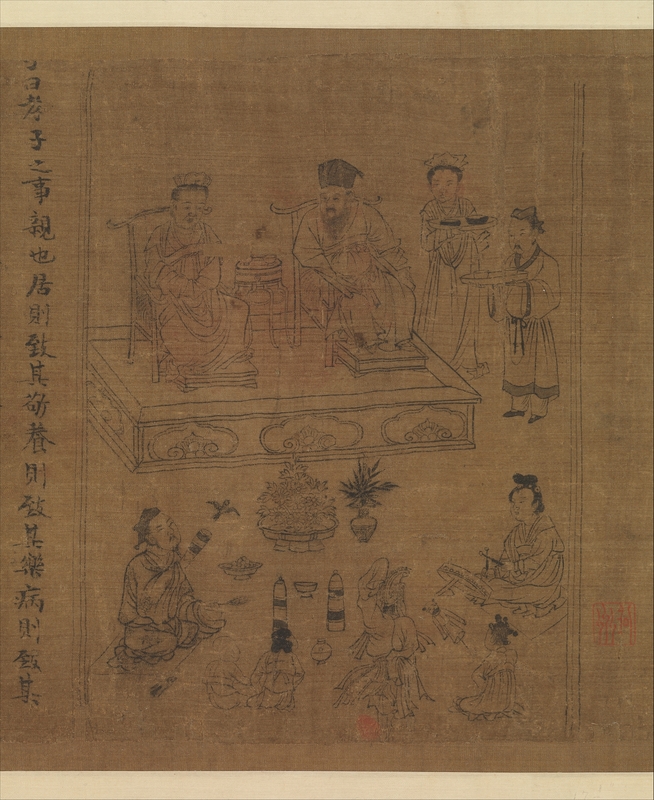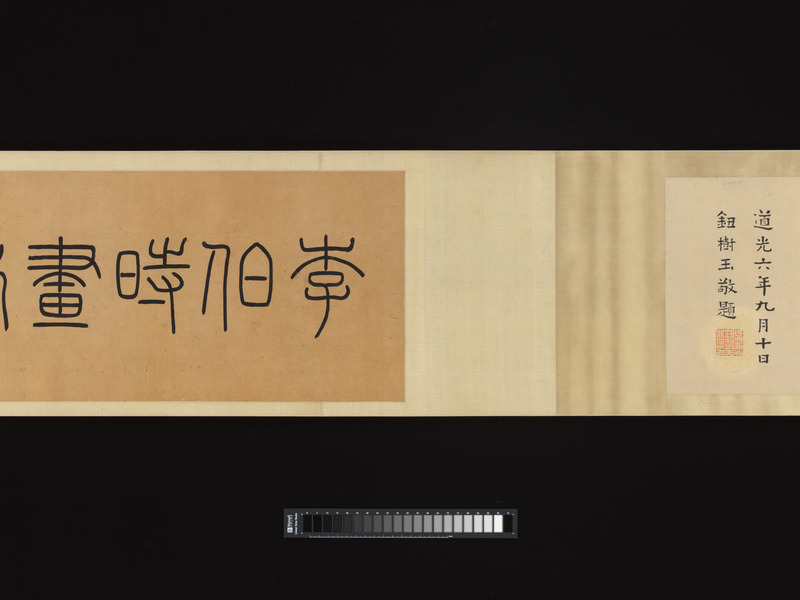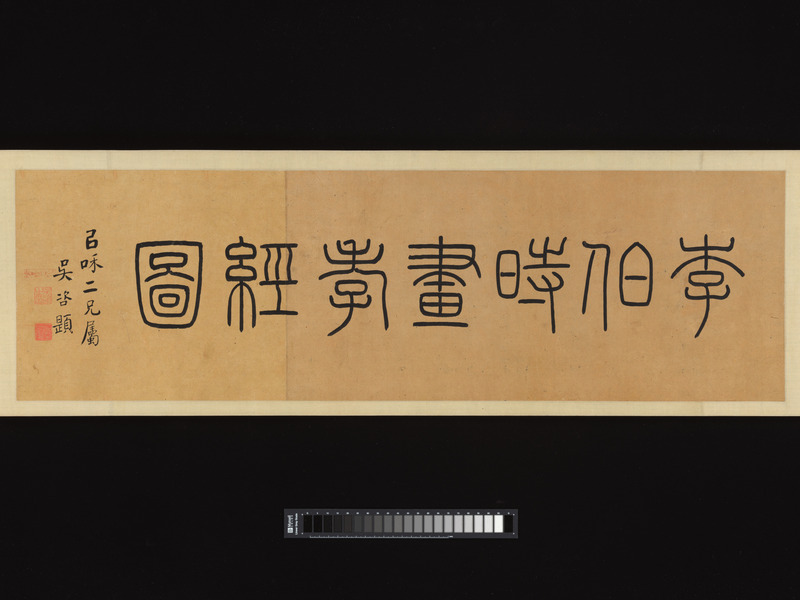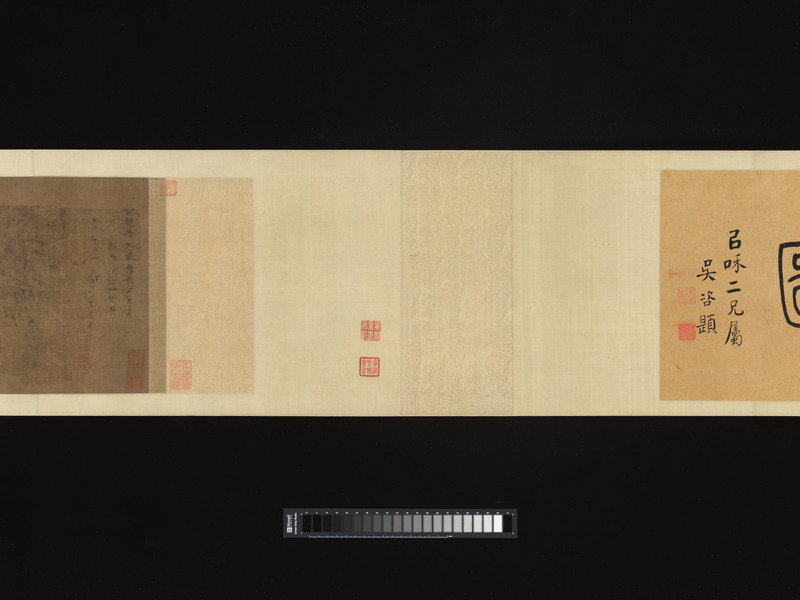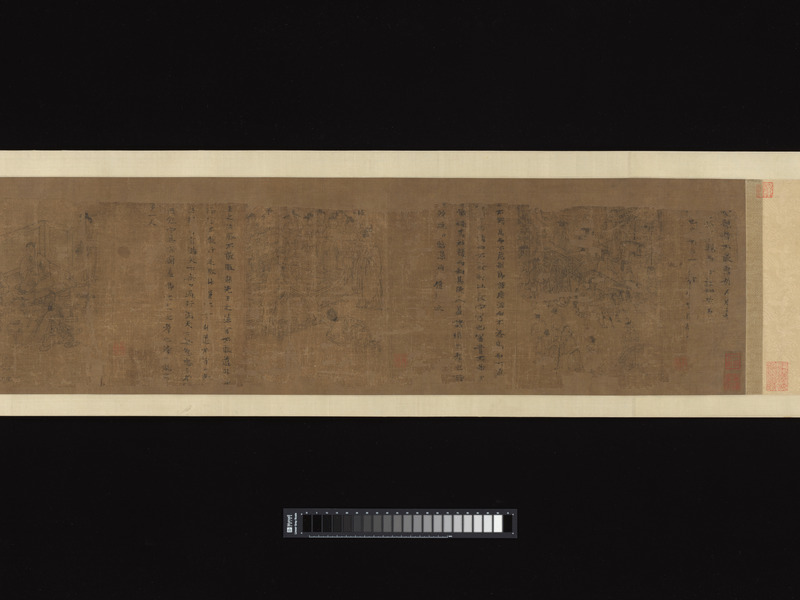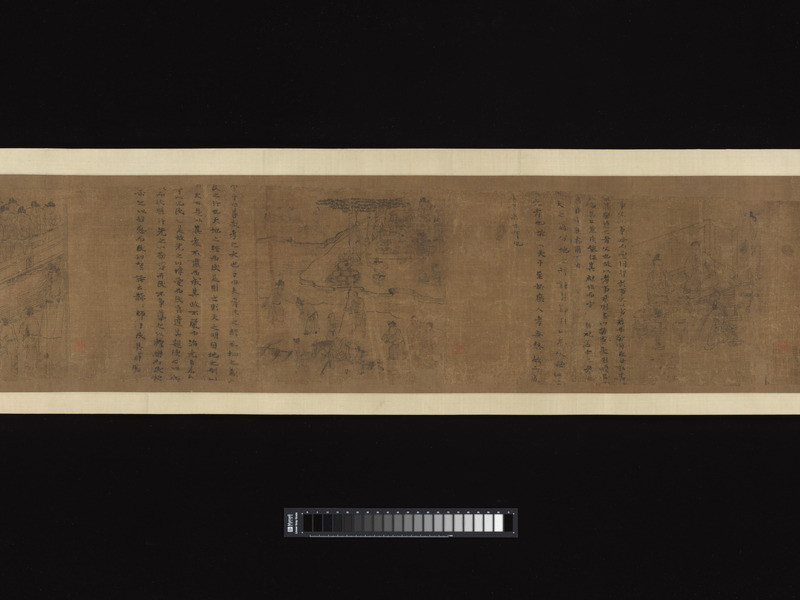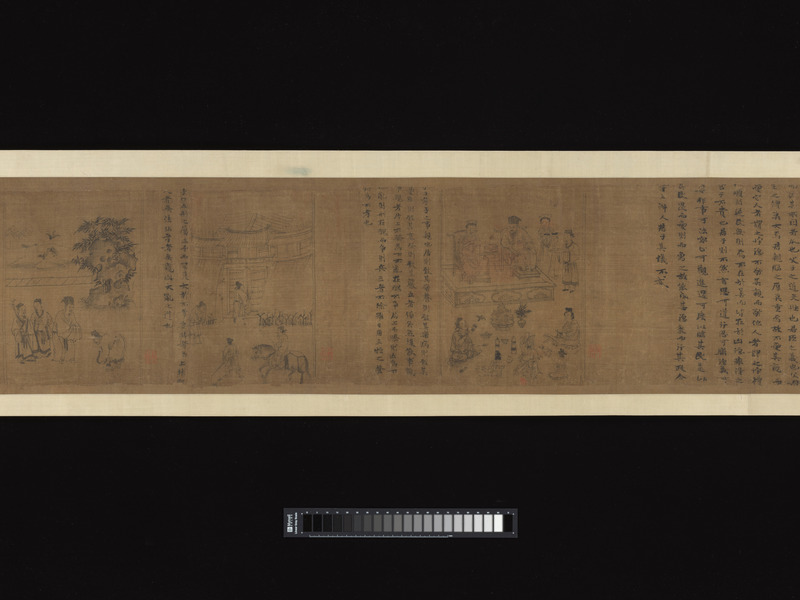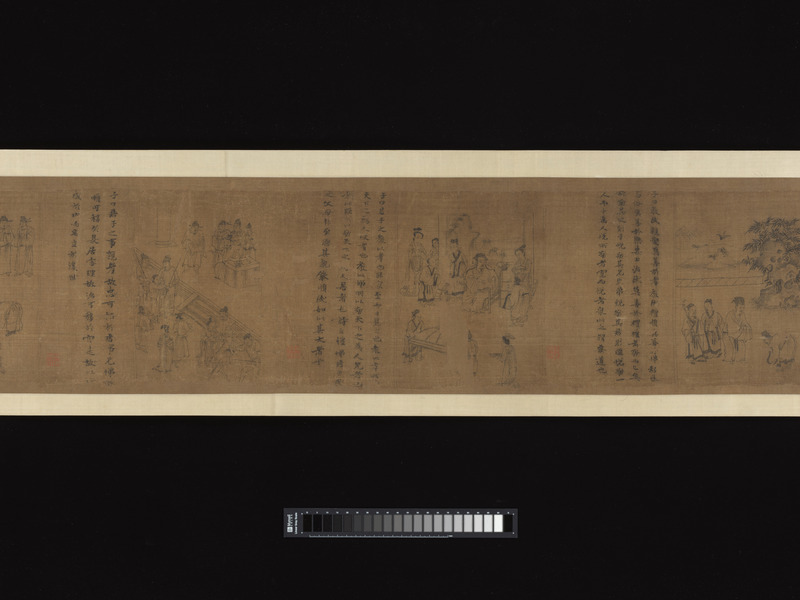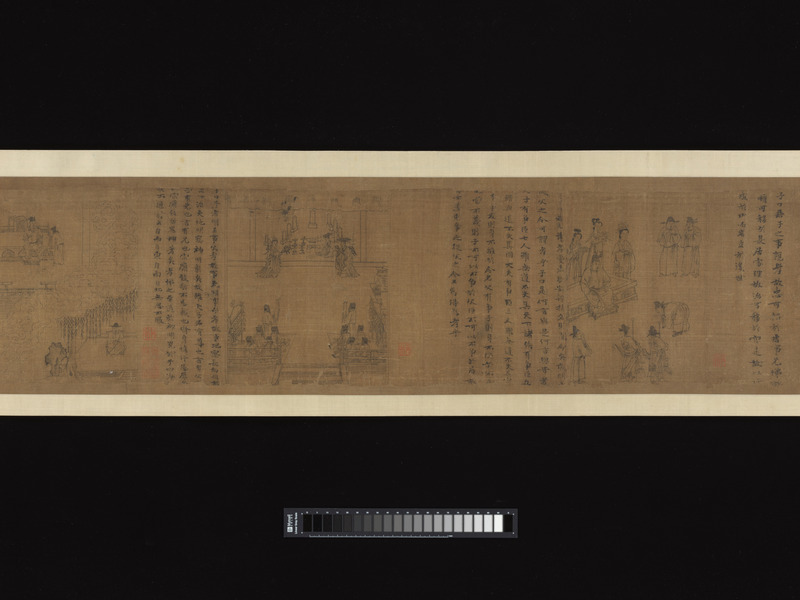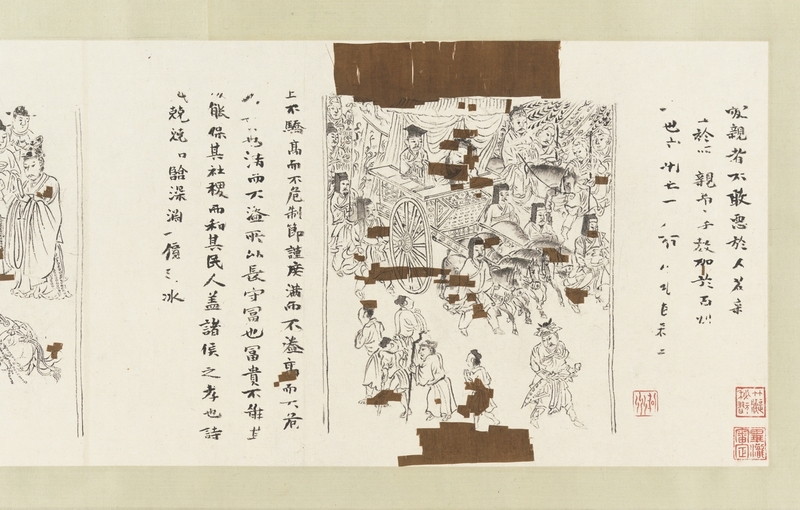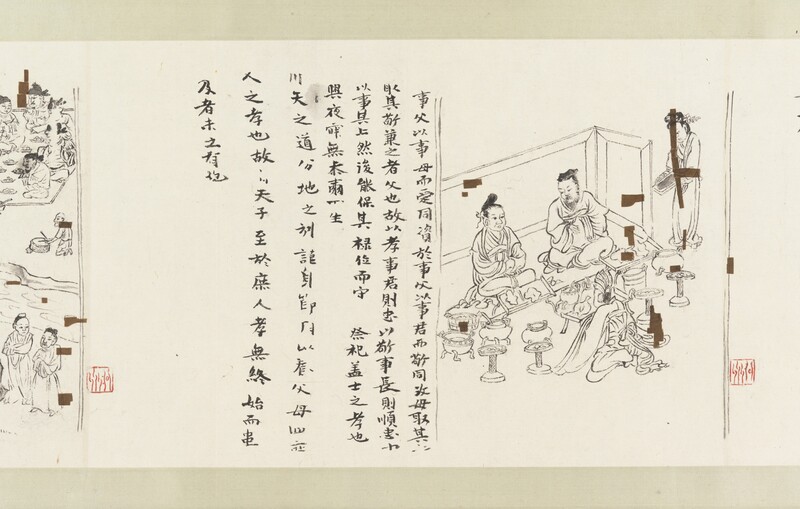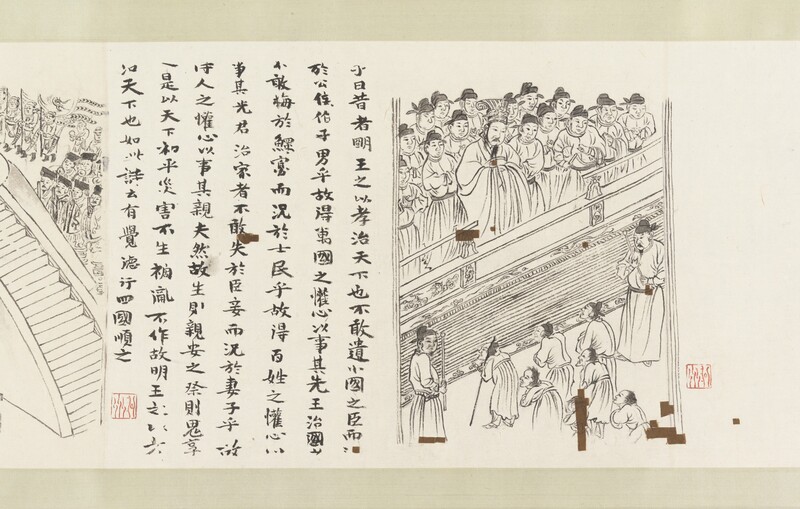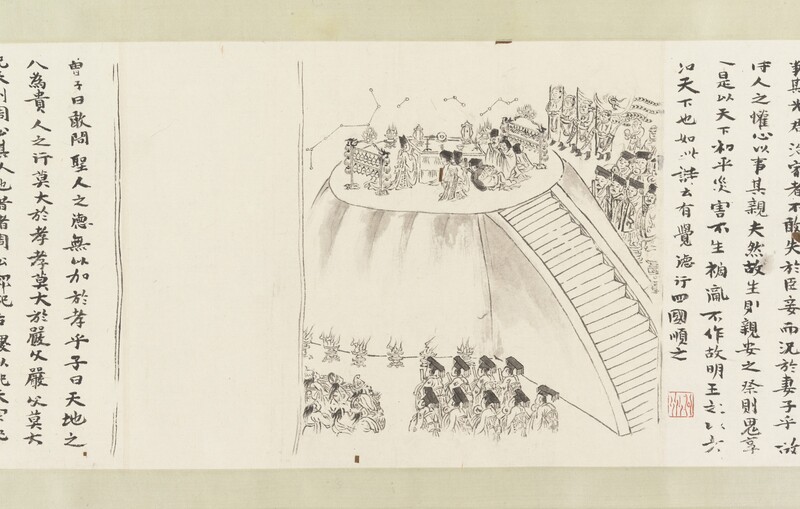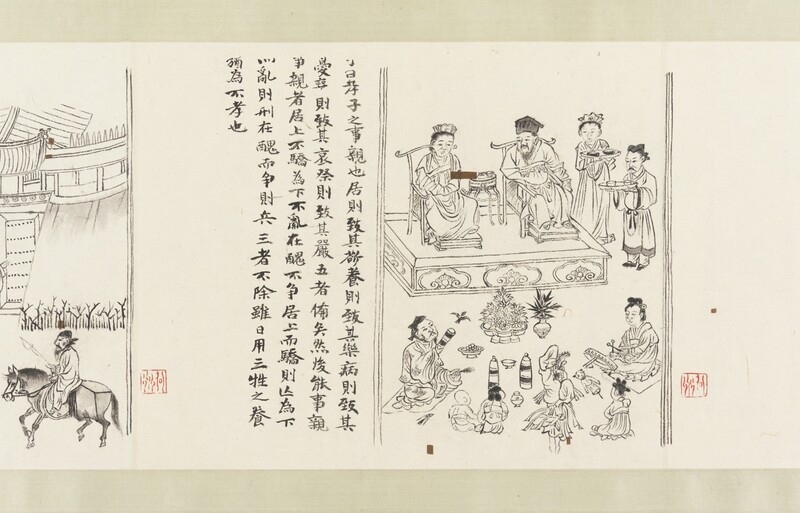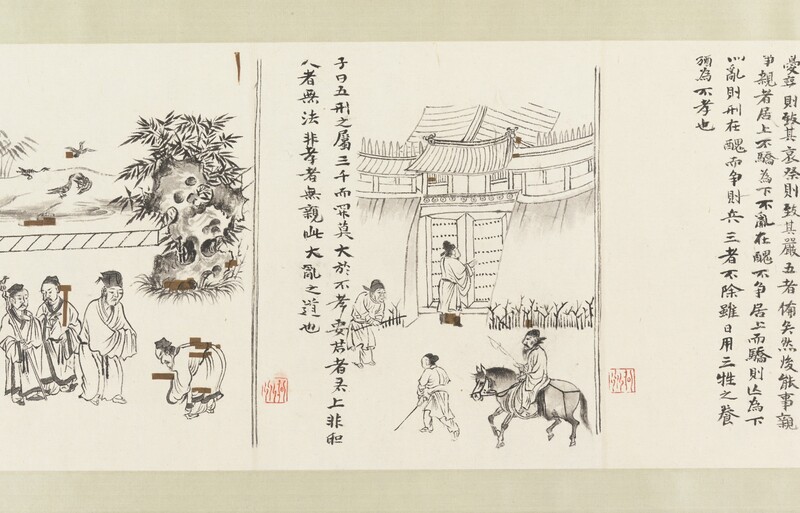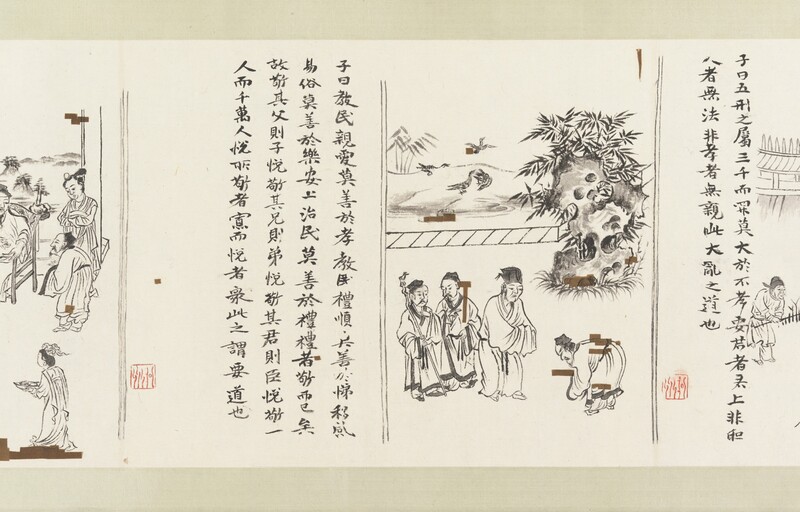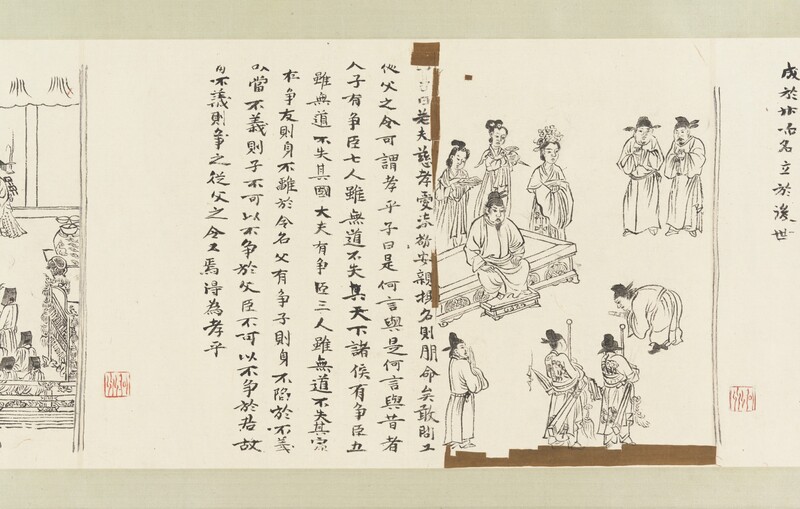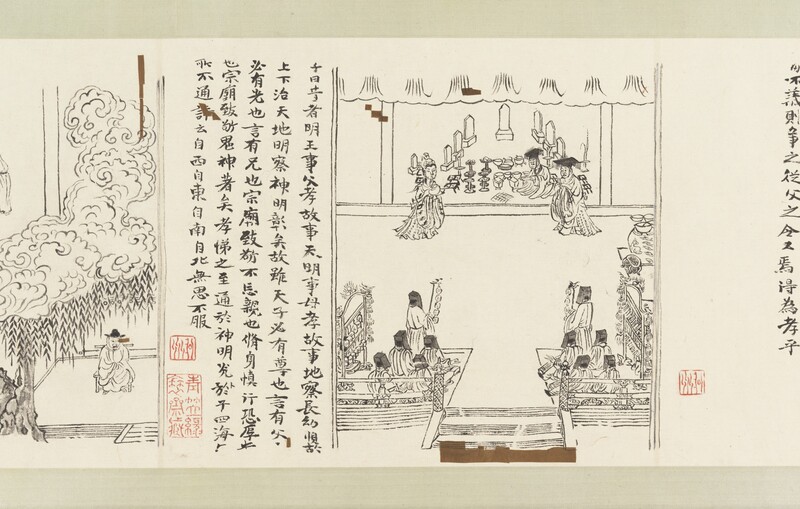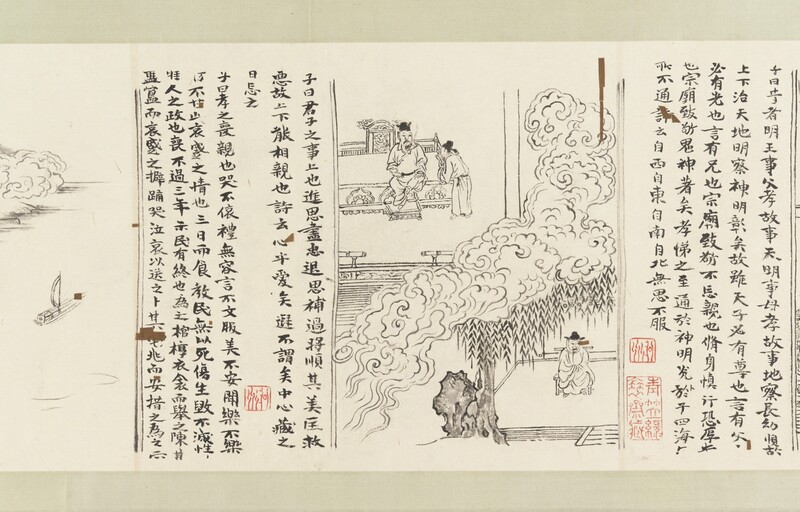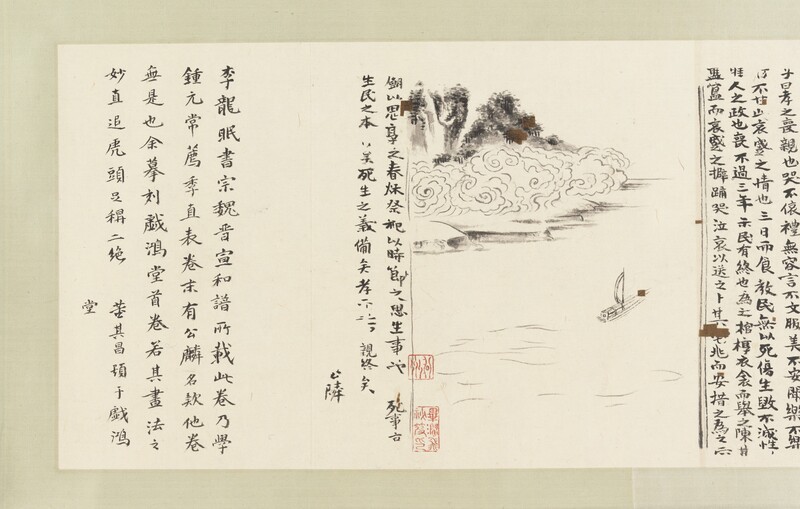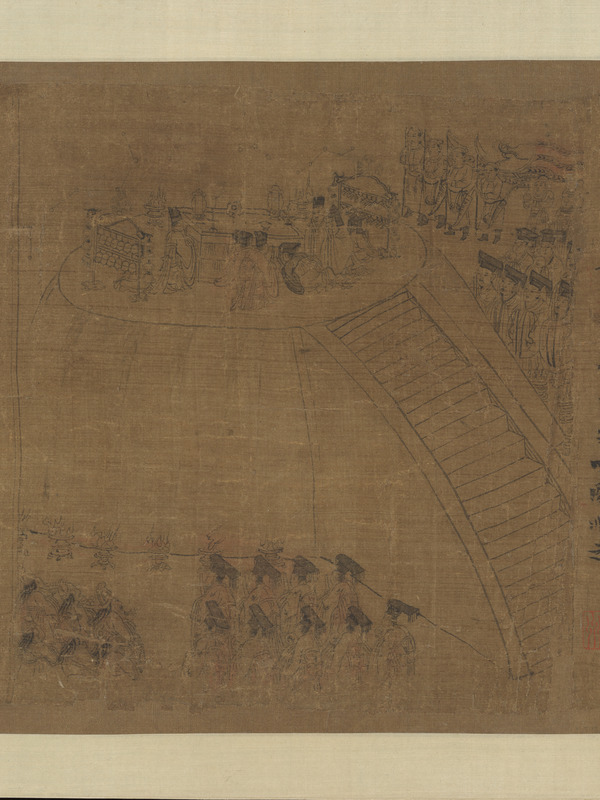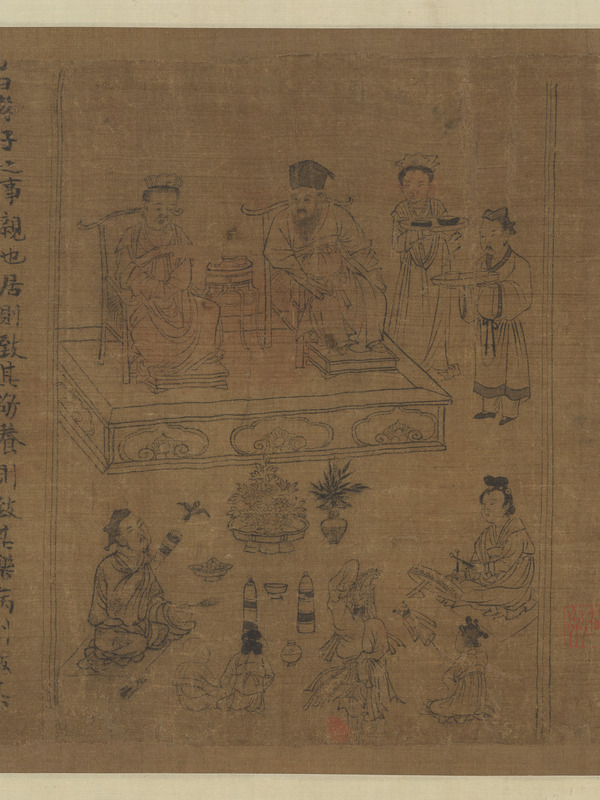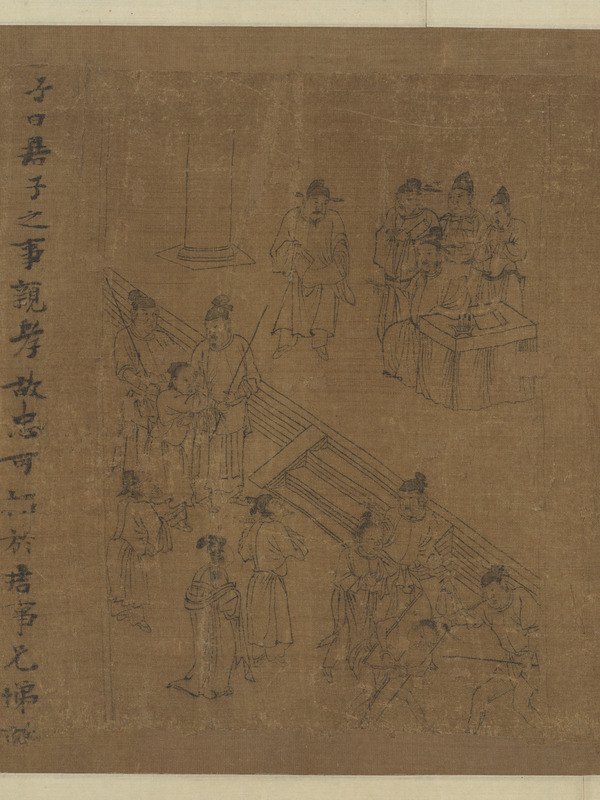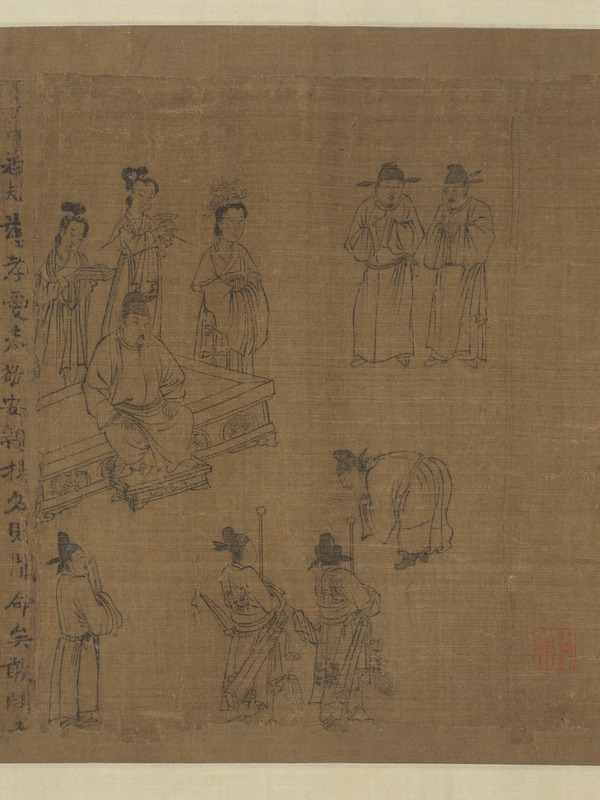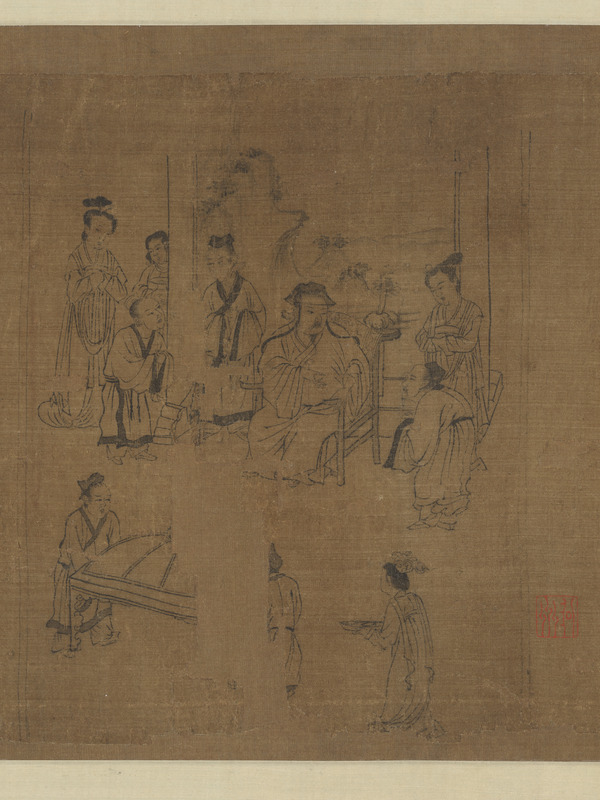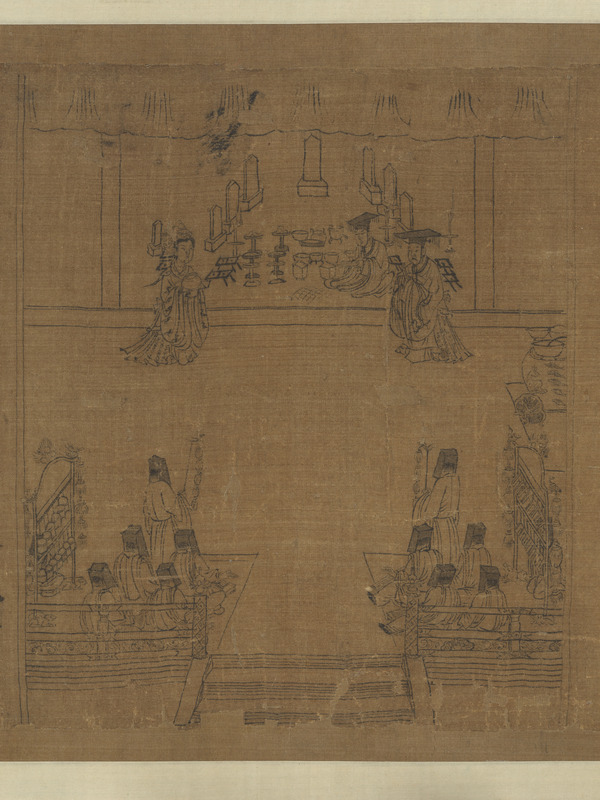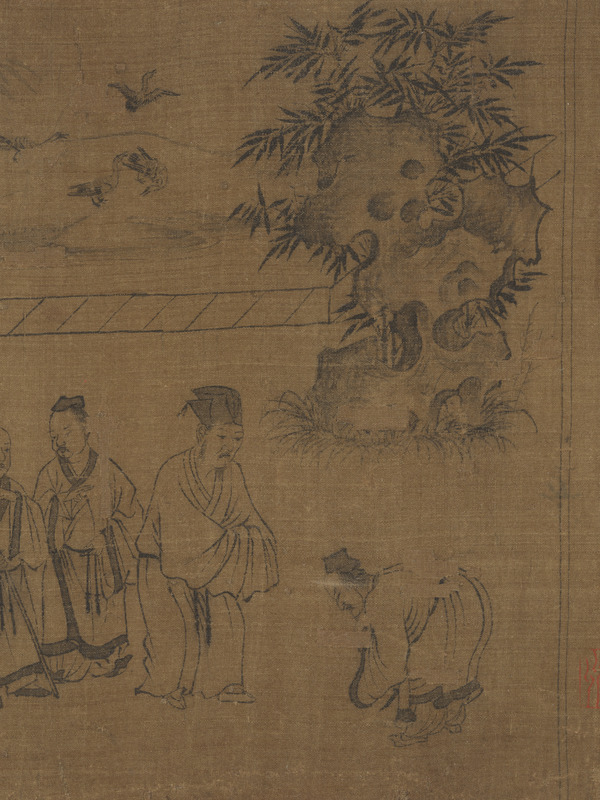The Classic of Filial Piety 孝經圖
Item
Title
The Classic of Filial Piety
孝經圖
孝經圖
Description
Artist's inscriptions and signature (86 columns in standard script in 17 sections, each following an illustration except the first and the fifth)
1. 3 columns in standard script [Chapter 2: Filial Piety in the Son of Heaven天子章第二, illustration not extant]:
He who loves his parents will not dare to hate any man….. (p. 85)[1]
…..愛親者不敢惡于人,…..於囗親囗囗囗囗囗囗也。…..
2. 4 columns in standard script [Chapter 3: Filial Piety in the Princes of State 諸侯章第三]:
When a prince is not proud and arrogant, he will not incur peril in spite of his high position. By exercising self-restraint he is judicious, ever keeping a proper balance between his need and use of material things. By such moderation his cup of wealth is full without wasteful overflow. And thus, preserving wealth and rank, he will be able to retain possession of his altars of the land and the grain and keep his subjects in peace. This is the filial piety for the prince of state. It is said in the Book of Songs:
Be apprehensive, be cautious,
As if on the brink of a deep abyss,
As if treading on thin ice. (p. 88)
囗上不驕,高而不危。制節謹度,滿而不溢。高而不危,囗囗囗囗也。滿而不溢,所以長守富也。富貴不離囗囗,囗囗能保其社稷,而和其民人,蓋諸侯之孝也。《詩》囗:“囗囗兢兢,如臨深淵,如履薄冰。”
3. 5 columns in standard script [Chapter 4: Filial Piety in High Ministers and Great Officers 卿大夫章第四]:
They do not presume to wear robes other than those appointed by the laws of the ancient kings, nor to speak words other than those sanctioned by them, nor to exhibit conduct other than that exemplified by their virtuous ways. Thus, none of their words being contrary to those sanctions, and none of their actions contrary to the Way, from their mouths there comes no objectionable speech, and in their conduct there are found no objectionable actions. Their words may fill all under heaven, yet no error of speech will be found in them. Their actions may fill all under heaven, yet no dissatisfaction or dislike will be awakened by them. When these three things are all complete, and as they should be, they can then preserve their ancestral temples. This is the filial piety of high ministers and great officers. In the Book of Songs it is said:
He is never idle, day or night,
In the service of the One Man. (p. 93)
囗囗王之法服,不敢服。非先王之法言,不敢道。非先王之德行,不敢行。 是故非法不言,非道不行,囗無囗囗囗無擇行,言滿天下無囗過, 行滿天下無怨惡。三者囗囗囗囗能守其宗廟,盖卿大夫之孝也。《詩》 云: “夙夜囗囗囗事一人。”
4. 4 columns in standard script [Chapter 5: Filial Piety in Lesser Officials 士章第五]:
As they serve their fathers, so they serve their mothers, and they love them equally. As they serve their fathers, so they serve their rulers, and they reverence them equally. Hence, love is what is chiefly rendered to the ruler, while both of these things are given to the father. Therefore, when they serve their ruler with filial piety they are loyal; when they serve their superior with reverence they are obedient. Not failing in this loyalty and obedience in serving those above them, they are then able to preserve their emoluments and positions, and to maintain their sacrifices. This is the filial piety of the lesser officials. It is said in the Book of Songs:
Rising early and going to sleep late,
Do not disgrace those who gave you birth. (p. 98)
囗囗事父以事母,而愛同。資於事父以事君,而敬同。故母取其囗囗囗取其敬,兼之者父也。故以孝事君,則忠以敬事長則順,忠囗囗囗以事其上,然後能保其祿位,而守囗祭祀,盖士之孝也。囗囗囗興夜寐,無忝爾囗生。
5. 3 columns in standard script [Chapter 6: Filial Piety in the Common People 庶人章第六, illustration not extant]:
They follow the course of heaven, and distinguish the advantages of the soil; they are careful of their conduct, and economical in their expenditure—all in order to nourish their parents. This is the filial piety of the common people. In this way, from the Son of Heaven down to the common people, there has never been one whose filial piety was without its beginning or its end upon whom calamity did not fall. (p. 102)
用天之道,分地之利,謹身節用,以養父母,此囗人之孝也。 故囗天子至於庶人,孝無終始,而患囗及者,未之有也。
6. 6 columns in standard script [Chapter 7: Filial Piety in Relation to the Three Powers三才章第七]:
Zengzi said, “Immense indeed is the greatness of filial piety!” The Master replied, “Yes, filial piety is the constant pattern of heaven, the righteousness of earth, and the duty of man. Heaven and earth inevitably pursue their course, and the people take it as their pattern. The ancient kings imitated the brilliant luminaries of heaven, and acted in accordance with the advantages afforded by the earth, and were thus in accord with all under heaven. Consequently, their teachings were successful without being severe, and their government secured perfect order without being repressive. The ancient kings, seeing how their teachings could transform the people, set before them therefore an example of the most extended love, and none of the people neglected their parents; they set forth to them the example of virtue and righteousness, and the people roused themselves to the practice of them; they went before them with reverence and yielding courtesy, and the people had no contentions; they led them by the rules of propriety and by music, and the people were harmonious and benign; they showed them what they liked and disliked, and the people understood their prohibitions. It is said in the Book of Songs:
Awe-inspiring are you, O Grand Master Yin,
And all of the people look up to you.” (p. 105)
曾子曰:“甚哉。孝之大也。”子曰:“夫孝,天之經也。”地之義囗,民之行也。天地之經,而民是則之,則天之明,因地之利,以囗天下。是以其教不肅而成,其政不嚴而治。先王見囗囗可以化民囗,是故先之以博愛,而民莫遺其親。陳之以德囗,而民興行。先之以敬讓,而民不爭。導之以禮樂,而民和囗。示之以好惡,而民知禁。《詩》云:‘赫赫師尹,民具爾瞻。’”
7. 7 columns in standard script [Chapter 8: Filial Piety in Government 孝治章第八]:
The Master said, “In former times, when the intelligent kings by means of filial piety ruled all under heaven, they did not dare to receive with disrespect the ministers even of small states. How much less would they have dared with dukes, marquises, counts, and barons! Thus it was that they got the myriad states to serve with joyful hearts their royal ancestors.
“The rulers of states did not dare to slight wifeless men and widows. How much less would they slight their officers and subjects! Thus it was that they got all the people to serve with joyful hearts the rulers, their predecessors.
“The heads of clans did not dare to slight their servants and concubines. How much less would they slight their wives and sons! Thus it was that they got the men in the service of their parents with joyful hearts.
“In such a state of things, the parents, while alive, reposed in their songs; and when sacrificed to, their disembodied spirits enjoyed the offerings made to them. Thus, everywhere under heaven, peace and harmony prevailed; disaster and calamities did not occur; misfortunes and rebellions did not arise. It is said in the Book of Songs:
To upright and virtuous conduct
In all the four quarters of the state,
render obedient homage.” (p. 109)
子曰:“昔者明王之以孝治天下也,不敢遺小國之臣,而□於公、侯、伯、子、男乎,故得萬國之懽心。以事其先王。治國囗不敢侮於鰥寡,而況於士民乎,故得百姓之懽心,囗事其先君。治家者不敢失於臣妾,而況於妻子乎,故得人之懽心,以事其親。夫然,故生則親安之,祭則鬼享囗。是以天下和平,災害不生,禍亂不作。故明王之以孝治天下也如此。《詩》 云:‘有覺德行,四國順之。’”
8. 14 columns in standard script [Chapter 9: The Government of the Stages 聖治章第九]:
Zengzi said, “I venture to ask whether in the virtues of the sages there was not something greater than filial piety.” The Master replied, “Of all the living natures produced by heaven and earth, man is the noblest. Of all the actions of man, there is none greater than filial piety. In filial piety there is nothing greater than the reverential awe of one’s father. In the reverential awe shown to one’s father there is nothing greater than making him the companion of heaven. The duke of Zhou was the man who first did this. Formerly, at the border altar, the duke of Zhou sacrificed to Houji as the companion of heaven, and in the Bright Hall he honored King Wen, and sacrificed to him as the companion of God. As a consequence, all of the princes within the Four Seas came to offer assistance in the performance of the sacrifices. In the virtue of the sages, what is there greater than filial piety? Now, the feelings of affection grow at the parents’ knees, and as the nourishing of the parents is practiced those affections merge into awe. The sages proceeded from awe to reverence, and from affection to love. The teaching of the sages, without being severe, were successful, and their government, without being rigorous, was effective. What they proceeded from was the roof of filial piety. The relationship and duties between father and son are of heaven-sent nature, and hold the principle of righteousness between ruler and subject. The son derives his life from his parents, and no greater gift can be transmitted. Ruler and parents in one, his gather deals with him accordingly, and there is no generosity greater than this. Therefore, he who does not love his parents, but instead loves other men, is called a rebel against virtue. He who does not revere his parents, but reveres instead other men, is called a rebel against propriety. When a ruler himself thus acts contrary to that which should place him in accord with all men, he presents nothing for the people to imitate. He has nothing to do with what is good, but entirely and only with what is injurious to virtues. Though he may succeed, the superior man does not give him approval. It is not so with the superior man. He speaks, having thought whether the words should be spoken; he acts, having thought whether his actions are certain to give pleasure. His virtue and righteousness are such as will be honored; what he initiates and carries out is fit to be imitated; his deportment is worthy of contemplation; his movements in advancing or retiring are all according to the proper rule. In this way does he present himself to the people, who both revere and love him, imitate and become like him. Thus he is able to make his teaching of virtue successful, and his government and orders to be carried into effect. It is said in the Book of Songs:
The virtuous man, the princely one,
Has no flaw in his deportment.” (p. 113)
曾子曰:“敢問聖人之德,無以加於孝乎。”子曰:“天地之囗囗人為貴。人之行,莫大於孝。孝莫大於嚴父,嚴父莫大囗配天,則周公其人也。昔者周公郊祀后稷,以配天。宗祀囗王於明堂,以配上帝。是以四海之內,各以其職來祭。夫聖囗囗之德,又何以加於孝乎。故親生之膝下,以養父母日嚴。聖囗因嚴以教敬,因親以教愛。聖人之教不肅而成,其政不嚴而治, 其所因者本也。父子之道,天性也。君臣之義也。父母生之,續莫大焉。君親臨之,厚莫重焉。故不愛其親而愛它人者,謂之悖德。不敬其親而敬他人者,謂之悖禮。囗順則逆民,無則焉不在於善,而皆在於凶德。雖得之,君子不貴也。君子則不然,言思可道,行思可樂,德義可尊,作事可法,容止可觀,進退可度,以臨其民。是以其民畏而愛,則而象之。故能成其德教,而行其政令。《詩》云:‘淑人君子,其儀不忒。’”
9. 5 columns in standard script [Chapter 10: An orderly Description of the Acts of Filial Piety 紀孝行章第十]:
The Master said, “The service which a son renders to his parents is as follows. In his general conduct toward them he manifests the utmost reverence. In his nourishing of them, his endeavor is to give them the utmost pleasure. When they are ill, he feels the greatest anxiety. In mourning for them, he exhibits every manifestation of grief. In sacrificing to them, he displays the utmost solemnity. When a son is complete in these five things, he is able to serve his parents. He who thus serves his parents, in a high situation, will be free from pride; in a low situation, will be free from insubordination; and, among his equals, will not be quarrelsome. In a high situation pride leads to ruin; in a low situation insubordination leads to punishment; among equals quarrelsomeness leads to the wielding of weapons. If those three things be not put away, even though a son every day contributes beef, mutton, and pork to nourish his parents, he is not filial.” (p. 118)
子曰:“孝子之事親也,居則致其敬,養則致其樂,病則致其憂,喪則致其哀,祭則致其嚴,五者備矣,然後能事親。事親者,居上不驕,為下不亂,在醜不爭,居上而驕,則亡。為下而亂,則刑。在醜而爭,則兵。三者不除,雖日用三牲之養,猶為不孝也。”
10. 2 columns in standard script [Chapter 11: Filial Piety in Relation to the Five Punishments 五刑章第十一]:
The Master said, “There are three thousand offenses against which the five punishments are directed, and there is not one of them greater than being unfilial. When constraint is put upon a ruler, that is the disowning of his superiority. When the authority of the sages is disallowed, that is the disowning of law. When filial piety is put aside, that is the disowning of the principle of affection. This paves the way to anarchy.” (p. 122)
子曰:“五刑之屬三千,而罪莫大於不孝,要君者無上,非聖人者無法,非孝者無親,此大亂之道也。”
11. 4 columns in standard script [Chapter 12: Amplification of “The All-Embracing Rule of Conduct” in Chapter 1廣要道章第十二]:
The Master said, “For teaching the people to be affectionate and loving there is nothing better than filial piety. For teaching them propriety and submissiveness there is nothing better than fraternal duty. For changing their manners and altering their customs there is nothing better than music. For securing the repose of superiors and the good order of the people there is nothing better than propriety. Propriety is simply respect. Therefore, the respect paid to one’s father pleases all sons; the respect paid to one’s elder brother pleases all younger sons; the respect paid to one’s ruler pleases all subjects. The respect paid to one man pleases thousands and myriads of men. The respect is paid to a few and the pleasure extends to many—this is what is meant by the Essential Way.” (p. 127)
子曰:“教民親愛,莫善於孝。教民禮順,莫善於悌。移風易俗,莫善於樂。安上治民,莫善於禮。禮者,敬而已矣。故敬其父,則子悅。敬其兄,則弟悅。敬其君,則臣悅。敬一人而千萬人悅。所敬者寡而悅者眾,此謂之要道也。”
12. 4 columns in standard script [Chapter 13: Amplification of “The Perfect Virtue” in Chapter 1 廣至德章第十三]:
The master said, “The teaching of filial piety by the superior man does not require that he should go to family after family, and daily see the members of each. His teaching of filial piety is a tribute of reverence to all the fathers under heaven. His teaching of fraternal submission is a tribute of reverence to all the elder brothers under heaven. His teaching of the duty of a subject is a tribute of reverence to all the rulers under heaven. It is said in the Book of Songs:
The happy and courteous sovereign
Is the parent of the people.
“If it were not a perfect virtue, how could it be recognized as in accordance with their nature by the people so extensively as this?” (p. 132)
子曰:“君子之教以孝也,非家至而日見之也。教以孝,所囗天下之為人父者也。教以悌,所以敬天下之為人兄者也。教以臣,所以敬天下之囗人君者也。《詩》云:‘愷悌君子,民之父母。’非至德,其孰能順民如此其大者乎。”
13. 3 columns in standard script [Chapter 14: Amplification of “Making Our Name Famous” in Chapter 1 廣揚名章第十四]:
The Master said, “The filial piety with which the superior man serves his parents may be transferred as loyalty to the ruler. The fraternal duty with which he serves the eldest brother may be transferred as submissive deference to elders. His regulation of his family may be transferred as good government in any official position. Therefore, when his conduct is thus successful in his inner circle, his name will be established for future generations.” (p. 136)
子曰:“君子之事親孝,故忠可移於君。事兄悌,故順可移於長。居家理,故治可移於官。是故以行成於內,而名立於後世。”
14. 7 columns in standard script [Chapter 15: Filial Piety in Relation to Reproof and Remonstrance 諫諍章第十五]:
Zengzi said: “I have heard your instructions on the affection of love, on respect and reverence, on giving repose to our parents, and on making our names famous. I would venture to ask if simple obedience to the orders of one’s father can be pronounced filial piety?” The Master replied: “What words are these! What words are these! In former times, if the Son of Heaven had seven ministers who would remonstrate with him, although he had not right methods of government, he would not lose possession of his kingdom; if the prince of a state had five such ministers, though his measures might be equally wrong, he would not lose his state; if a great officer had three, he would not, in a similar case, lose his clan; if an inferior officer had a friend who would remonstrate with him, a good name would not cease to be connected with his character; and the father who had a son that would remonstrate with him would not sink into the gulf or unrighteous deeds. Therefore, where a case of unrighteous conduct is concerned, a son must by no means keep from remonstrating with his father, nor a minister from remonstrating with his ruler. Hence, since remonstrance is required in the case of unrighteous conduct, how can simple obedience to the order of a father be accounted filial piety?” (p. 137)
囗囗曰:“若夫慈孝愛恭敬,安親揚名,則聞命矣。敢問囗囗父之令,可謂孝乎?”子曰:“是何言與?是何言與?昔者天子有爭臣七人,雖無道不失其天下。諸侯有爭臣囗囗,雖無道不失其國。大夫有爭臣三人,雖無道不失其家。囗有爭友,則身不離於令名。父有爭子,則身不陷於不義。囗當不義,則子不可以不爭於父, 臣不可以不爭於君,故囗不義則爭之,從父之令,又焉得為孝乎。”
15. 5 columns in standard script [Chapter 16: The Influence of Filial Piety and the Response to It 感應章第十六]:
The Master said, “In former times, the intelligent kings served their fathers with filial piety, and therefore they served earth with discrimination. They pursued the right course with reference to their seniors and juniors, and therefore they secured the regulation of the relations between superiors and inferiors everywhere. When heaven and earth were served with intelligence and discrimination, their spiritual intelligences displayed themselves. Therefore, even the Son of Heaven must have some whom he honors; that is, he has his uncles of his surname. He must have some to whom he concedes precedence; that is, he has his cousins, who bear the same surname, and are older than himself. In the ancestral temple he manifests the utmost reverence, showing that he does not forget his parents. He cultivates his person and is careful of his conduct, fearing lest he should disgrace his predecessors. When in the ancestral temple he exhibits the utmost reverence, the spirits of the departed manifest themselves. Perfect filial piety and fraternal duty reach to the spiritual intelligences, and diffuse their light on all within the Four Seas. They penetrate everywhere. It is said in the Book of Songs:
From the west to the east,
From the south to the north,
There was not a thought but did him homage.” (p. 143)
子曰:“昔者明王事父孝,故事天明事母孝,故事地察,長幼順,故上下治,天地明察,神明彰矣。故雖天子必有尊也,言有父囗必有先也。言有兄也,宗廟致敬,不忘親也。脩身慎行,恐辱先也。宗廟致敬,鬼神著矣。 孝悌之至,通於神明,光於乎四海,囗所不通。《詩》云:‘自西自東,自南自北,無思不服。’”
16. 7 columns in standard script [Chapter 17: The Service of the Ruler 事君章第十七]:
The Master said, “The superior man serves his ruler in such a way that, when at court in his presence, his thought is how to discharge his loyal duty to the utmost; and, when he retires from it, his thought is how to amend his errors. He carries out with deference the measures springing from his ruler’s excellent qualities, and rectifies him only to preserve him from what is evil. Hence, as superior and inferior they are able to have affection for one another. It is said in the Book of Songs:
In my heart I love him so,
And why should I not say so?
In the core of my heart I keep him,
And never will forget him.” (p. 147)
子曰:“君子之事上也,進思盡忠,退思補過,將順其美,匡救囗惡,故上下能相親也。《詩》 云:‘心乎愛矣,遐不謂矣,中心藏之,囗日忘之。’”
17. 6 columns in standard script, illustration between columns 4 and 5 [Chapter 18: Filial Piety in Mourning for Parents 喪親章第十八]:
The Master said, “When a filial son is mourning for a parent, he wails, but not with a prolonged sobbing; in the movements of ceremony, he pays no attention to his appearance; his words are without elegance of phrase; he cannot bear to wear fine clothes; when he hears music, he feels no delight; when he eats a delicacy, he is not conscious of its flavor. Such is the nature of grief and sorrow.
“After three days, he may partake of food; for thus the people are taught that the living should not be injured on account of the dead, and that emaciation must not be carried to the extinction of life. Such is the rule of the sages. The period of mourning does not extend beyond three years, to show the people that it must have an end.
“An inner and an outer coffin are made; the grave clothes also are put on, and the shroud; and the body is lifted into the coffin. The sacrificial vessels, round and square, are set forth, and cause further distress. The women beat their breasts and the men stamp their feet, wailing and weeping, while they sorrowfully escort the coffin to the grave. They consult the tortoiseshell to determine the grave and the ground about it, and they lay the body in peace. They prepare the ancestral temple, and there present offerings to the disembodied spirit. In the spring and autumn they offer sacrifices, thinking of the deceased as the seasons come round.
“The services of love and reverence to parents when alive, and those of grief and sorrow when they are dead—these completely discharge the fundamental duty of living men. The righteous claims of life and death are all satisfied, and the filial son’s service to his parents is completed.” (p. 150) Gonglin
子曰:“孝之喪親也,哭不偯,禮無容。言不文服美不安,聞樂不樂,囗旨不甘,此哀戚之情也。三日而食,教民無以死傷生,毀不滅性,囗囗人之政也。喪不過三年示民有終也。為之棺槨衣衾而舉之,陳其簠簋而哀慼之。擗踊哭泣,哀以送之,卜其宅兆,而安措之。為之宗廟,以鬼享之。春秋祭祀,以時節之思,生事愛囗,死事哀囗,生民之本囗矣,死生之義備矣,孝子之事親終矣。” 公麟
Artist’s seal
Illegible: 1
[1] All translations of the Classic of Filial Piety and the colophons come from Richard M. Barnhart, (essays by) Robert E. Harrist, Jr. and Hui-liang J. Chu., Li Kung-lin’s Classic of Filial Piety, New York: The Metropolitan Museum of Art, 1993. Page numbers are specified at the end of translation of each section. Barnhart’s translation of the Classic of Filial Piety is mostly based on James Legge, The Hsiao King, in The Sacred Books of China: The Texts of Confucianism, pt. 1, Oxford, 1879.
1. 3 columns in standard script [Chapter 2: Filial Piety in the Son of Heaven天子章第二, illustration not extant]:
He who loves his parents will not dare to hate any man….. (p. 85)[1]
…..愛親者不敢惡于人,…..於囗親囗囗囗囗囗囗也。…..
2. 4 columns in standard script [Chapter 3: Filial Piety in the Princes of State 諸侯章第三]:
When a prince is not proud and arrogant, he will not incur peril in spite of his high position. By exercising self-restraint he is judicious, ever keeping a proper balance between his need and use of material things. By such moderation his cup of wealth is full without wasteful overflow. And thus, preserving wealth and rank, he will be able to retain possession of his altars of the land and the grain and keep his subjects in peace. This is the filial piety for the prince of state. It is said in the Book of Songs:
Be apprehensive, be cautious,
As if on the brink of a deep abyss,
As if treading on thin ice. (p. 88)
囗上不驕,高而不危。制節謹度,滿而不溢。高而不危,囗囗囗囗也。滿而不溢,所以長守富也。富貴不離囗囗,囗囗能保其社稷,而和其民人,蓋諸侯之孝也。《詩》囗:“囗囗兢兢,如臨深淵,如履薄冰。”
3. 5 columns in standard script [Chapter 4: Filial Piety in High Ministers and Great Officers 卿大夫章第四]:
They do not presume to wear robes other than those appointed by the laws of the ancient kings, nor to speak words other than those sanctioned by them, nor to exhibit conduct other than that exemplified by their virtuous ways. Thus, none of their words being contrary to those sanctions, and none of their actions contrary to the Way, from their mouths there comes no objectionable speech, and in their conduct there are found no objectionable actions. Their words may fill all under heaven, yet no error of speech will be found in them. Their actions may fill all under heaven, yet no dissatisfaction or dislike will be awakened by them. When these three things are all complete, and as they should be, they can then preserve their ancestral temples. This is the filial piety of high ministers and great officers. In the Book of Songs it is said:
He is never idle, day or night,
In the service of the One Man. (p. 93)
囗囗王之法服,不敢服。非先王之法言,不敢道。非先王之德行,不敢行。 是故非法不言,非道不行,囗無囗囗囗無擇行,言滿天下無囗過, 行滿天下無怨惡。三者囗囗囗囗能守其宗廟,盖卿大夫之孝也。《詩》 云: “夙夜囗囗囗事一人。”
4. 4 columns in standard script [Chapter 5: Filial Piety in Lesser Officials 士章第五]:
As they serve their fathers, so they serve their mothers, and they love them equally. As they serve their fathers, so they serve their rulers, and they reverence them equally. Hence, love is what is chiefly rendered to the ruler, while both of these things are given to the father. Therefore, when they serve their ruler with filial piety they are loyal; when they serve their superior with reverence they are obedient. Not failing in this loyalty and obedience in serving those above them, they are then able to preserve their emoluments and positions, and to maintain their sacrifices. This is the filial piety of the lesser officials. It is said in the Book of Songs:
Rising early and going to sleep late,
Do not disgrace those who gave you birth. (p. 98)
囗囗事父以事母,而愛同。資於事父以事君,而敬同。故母取其囗囗囗取其敬,兼之者父也。故以孝事君,則忠以敬事長則順,忠囗囗囗以事其上,然後能保其祿位,而守囗祭祀,盖士之孝也。囗囗囗興夜寐,無忝爾囗生。
5. 3 columns in standard script [Chapter 6: Filial Piety in the Common People 庶人章第六, illustration not extant]:
They follow the course of heaven, and distinguish the advantages of the soil; they are careful of their conduct, and economical in their expenditure—all in order to nourish their parents. This is the filial piety of the common people. In this way, from the Son of Heaven down to the common people, there has never been one whose filial piety was without its beginning or its end upon whom calamity did not fall. (p. 102)
用天之道,分地之利,謹身節用,以養父母,此囗人之孝也。 故囗天子至於庶人,孝無終始,而患囗及者,未之有也。
6. 6 columns in standard script [Chapter 7: Filial Piety in Relation to the Three Powers三才章第七]:
Zengzi said, “Immense indeed is the greatness of filial piety!” The Master replied, “Yes, filial piety is the constant pattern of heaven, the righteousness of earth, and the duty of man. Heaven and earth inevitably pursue their course, and the people take it as their pattern. The ancient kings imitated the brilliant luminaries of heaven, and acted in accordance with the advantages afforded by the earth, and were thus in accord with all under heaven. Consequently, their teachings were successful without being severe, and their government secured perfect order without being repressive. The ancient kings, seeing how their teachings could transform the people, set before them therefore an example of the most extended love, and none of the people neglected their parents; they set forth to them the example of virtue and righteousness, and the people roused themselves to the practice of them; they went before them with reverence and yielding courtesy, and the people had no contentions; they led them by the rules of propriety and by music, and the people were harmonious and benign; they showed them what they liked and disliked, and the people understood their prohibitions. It is said in the Book of Songs:
Awe-inspiring are you, O Grand Master Yin,
And all of the people look up to you.” (p. 105)
曾子曰:“甚哉。孝之大也。”子曰:“夫孝,天之經也。”地之義囗,民之行也。天地之經,而民是則之,則天之明,因地之利,以囗天下。是以其教不肅而成,其政不嚴而治。先王見囗囗可以化民囗,是故先之以博愛,而民莫遺其親。陳之以德囗,而民興行。先之以敬讓,而民不爭。導之以禮樂,而民和囗。示之以好惡,而民知禁。《詩》云:‘赫赫師尹,民具爾瞻。’”
7. 7 columns in standard script [Chapter 8: Filial Piety in Government 孝治章第八]:
The Master said, “In former times, when the intelligent kings by means of filial piety ruled all under heaven, they did not dare to receive with disrespect the ministers even of small states. How much less would they have dared with dukes, marquises, counts, and barons! Thus it was that they got the myriad states to serve with joyful hearts their royal ancestors.
“The rulers of states did not dare to slight wifeless men and widows. How much less would they slight their officers and subjects! Thus it was that they got all the people to serve with joyful hearts the rulers, their predecessors.
“The heads of clans did not dare to slight their servants and concubines. How much less would they slight their wives and sons! Thus it was that they got the men in the service of their parents with joyful hearts.
“In such a state of things, the parents, while alive, reposed in their songs; and when sacrificed to, their disembodied spirits enjoyed the offerings made to them. Thus, everywhere under heaven, peace and harmony prevailed; disaster and calamities did not occur; misfortunes and rebellions did not arise. It is said in the Book of Songs:
To upright and virtuous conduct
In all the four quarters of the state,
render obedient homage.” (p. 109)
子曰:“昔者明王之以孝治天下也,不敢遺小國之臣,而□於公、侯、伯、子、男乎,故得萬國之懽心。以事其先王。治國囗不敢侮於鰥寡,而況於士民乎,故得百姓之懽心,囗事其先君。治家者不敢失於臣妾,而況於妻子乎,故得人之懽心,以事其親。夫然,故生則親安之,祭則鬼享囗。是以天下和平,災害不生,禍亂不作。故明王之以孝治天下也如此。《詩》 云:‘有覺德行,四國順之。’”
8. 14 columns in standard script [Chapter 9: The Government of the Stages 聖治章第九]:
Zengzi said, “I venture to ask whether in the virtues of the sages there was not something greater than filial piety.” The Master replied, “Of all the living natures produced by heaven and earth, man is the noblest. Of all the actions of man, there is none greater than filial piety. In filial piety there is nothing greater than the reverential awe of one’s father. In the reverential awe shown to one’s father there is nothing greater than making him the companion of heaven. The duke of Zhou was the man who first did this. Formerly, at the border altar, the duke of Zhou sacrificed to Houji as the companion of heaven, and in the Bright Hall he honored King Wen, and sacrificed to him as the companion of God. As a consequence, all of the princes within the Four Seas came to offer assistance in the performance of the sacrifices. In the virtue of the sages, what is there greater than filial piety? Now, the feelings of affection grow at the parents’ knees, and as the nourishing of the parents is practiced those affections merge into awe. The sages proceeded from awe to reverence, and from affection to love. The teaching of the sages, without being severe, were successful, and their government, without being rigorous, was effective. What they proceeded from was the roof of filial piety. The relationship and duties between father and son are of heaven-sent nature, and hold the principle of righteousness between ruler and subject. The son derives his life from his parents, and no greater gift can be transmitted. Ruler and parents in one, his gather deals with him accordingly, and there is no generosity greater than this. Therefore, he who does not love his parents, but instead loves other men, is called a rebel against virtue. He who does not revere his parents, but reveres instead other men, is called a rebel against propriety. When a ruler himself thus acts contrary to that which should place him in accord with all men, he presents nothing for the people to imitate. He has nothing to do with what is good, but entirely and only with what is injurious to virtues. Though he may succeed, the superior man does not give him approval. It is not so with the superior man. He speaks, having thought whether the words should be spoken; he acts, having thought whether his actions are certain to give pleasure. His virtue and righteousness are such as will be honored; what he initiates and carries out is fit to be imitated; his deportment is worthy of contemplation; his movements in advancing or retiring are all according to the proper rule. In this way does he present himself to the people, who both revere and love him, imitate and become like him. Thus he is able to make his teaching of virtue successful, and his government and orders to be carried into effect. It is said in the Book of Songs:
The virtuous man, the princely one,
Has no flaw in his deportment.” (p. 113)
曾子曰:“敢問聖人之德,無以加於孝乎。”子曰:“天地之囗囗人為貴。人之行,莫大於孝。孝莫大於嚴父,嚴父莫大囗配天,則周公其人也。昔者周公郊祀后稷,以配天。宗祀囗王於明堂,以配上帝。是以四海之內,各以其職來祭。夫聖囗囗之德,又何以加於孝乎。故親生之膝下,以養父母日嚴。聖囗因嚴以教敬,因親以教愛。聖人之教不肅而成,其政不嚴而治, 其所因者本也。父子之道,天性也。君臣之義也。父母生之,續莫大焉。君親臨之,厚莫重焉。故不愛其親而愛它人者,謂之悖德。不敬其親而敬他人者,謂之悖禮。囗順則逆民,無則焉不在於善,而皆在於凶德。雖得之,君子不貴也。君子則不然,言思可道,行思可樂,德義可尊,作事可法,容止可觀,進退可度,以臨其民。是以其民畏而愛,則而象之。故能成其德教,而行其政令。《詩》云:‘淑人君子,其儀不忒。’”
9. 5 columns in standard script [Chapter 10: An orderly Description of the Acts of Filial Piety 紀孝行章第十]:
The Master said, “The service which a son renders to his parents is as follows. In his general conduct toward them he manifests the utmost reverence. In his nourishing of them, his endeavor is to give them the utmost pleasure. When they are ill, he feels the greatest anxiety. In mourning for them, he exhibits every manifestation of grief. In sacrificing to them, he displays the utmost solemnity. When a son is complete in these five things, he is able to serve his parents. He who thus serves his parents, in a high situation, will be free from pride; in a low situation, will be free from insubordination; and, among his equals, will not be quarrelsome. In a high situation pride leads to ruin; in a low situation insubordination leads to punishment; among equals quarrelsomeness leads to the wielding of weapons. If those three things be not put away, even though a son every day contributes beef, mutton, and pork to nourish his parents, he is not filial.” (p. 118)
子曰:“孝子之事親也,居則致其敬,養則致其樂,病則致其憂,喪則致其哀,祭則致其嚴,五者備矣,然後能事親。事親者,居上不驕,為下不亂,在醜不爭,居上而驕,則亡。為下而亂,則刑。在醜而爭,則兵。三者不除,雖日用三牲之養,猶為不孝也。”
10. 2 columns in standard script [Chapter 11: Filial Piety in Relation to the Five Punishments 五刑章第十一]:
The Master said, “There are three thousand offenses against which the five punishments are directed, and there is not one of them greater than being unfilial. When constraint is put upon a ruler, that is the disowning of his superiority. When the authority of the sages is disallowed, that is the disowning of law. When filial piety is put aside, that is the disowning of the principle of affection. This paves the way to anarchy.” (p. 122)
子曰:“五刑之屬三千,而罪莫大於不孝,要君者無上,非聖人者無法,非孝者無親,此大亂之道也。”
11. 4 columns in standard script [Chapter 12: Amplification of “The All-Embracing Rule of Conduct” in Chapter 1廣要道章第十二]:
The Master said, “For teaching the people to be affectionate and loving there is nothing better than filial piety. For teaching them propriety and submissiveness there is nothing better than fraternal duty. For changing their manners and altering their customs there is nothing better than music. For securing the repose of superiors and the good order of the people there is nothing better than propriety. Propriety is simply respect. Therefore, the respect paid to one’s father pleases all sons; the respect paid to one’s elder brother pleases all younger sons; the respect paid to one’s ruler pleases all subjects. The respect paid to one man pleases thousands and myriads of men. The respect is paid to a few and the pleasure extends to many—this is what is meant by the Essential Way.” (p. 127)
子曰:“教民親愛,莫善於孝。教民禮順,莫善於悌。移風易俗,莫善於樂。安上治民,莫善於禮。禮者,敬而已矣。故敬其父,則子悅。敬其兄,則弟悅。敬其君,則臣悅。敬一人而千萬人悅。所敬者寡而悅者眾,此謂之要道也。”
12. 4 columns in standard script [Chapter 13: Amplification of “The Perfect Virtue” in Chapter 1 廣至德章第十三]:
The master said, “The teaching of filial piety by the superior man does not require that he should go to family after family, and daily see the members of each. His teaching of filial piety is a tribute of reverence to all the fathers under heaven. His teaching of fraternal submission is a tribute of reverence to all the elder brothers under heaven. His teaching of the duty of a subject is a tribute of reverence to all the rulers under heaven. It is said in the Book of Songs:
The happy and courteous sovereign
Is the parent of the people.
“If it were not a perfect virtue, how could it be recognized as in accordance with their nature by the people so extensively as this?” (p. 132)
子曰:“君子之教以孝也,非家至而日見之也。教以孝,所囗天下之為人父者也。教以悌,所以敬天下之為人兄者也。教以臣,所以敬天下之囗人君者也。《詩》云:‘愷悌君子,民之父母。’非至德,其孰能順民如此其大者乎。”
13. 3 columns in standard script [Chapter 14: Amplification of “Making Our Name Famous” in Chapter 1 廣揚名章第十四]:
The Master said, “The filial piety with which the superior man serves his parents may be transferred as loyalty to the ruler. The fraternal duty with which he serves the eldest brother may be transferred as submissive deference to elders. His regulation of his family may be transferred as good government in any official position. Therefore, when his conduct is thus successful in his inner circle, his name will be established for future generations.” (p. 136)
子曰:“君子之事親孝,故忠可移於君。事兄悌,故順可移於長。居家理,故治可移於官。是故以行成於內,而名立於後世。”
14. 7 columns in standard script [Chapter 15: Filial Piety in Relation to Reproof and Remonstrance 諫諍章第十五]:
Zengzi said: “I have heard your instructions on the affection of love, on respect and reverence, on giving repose to our parents, and on making our names famous. I would venture to ask if simple obedience to the orders of one’s father can be pronounced filial piety?” The Master replied: “What words are these! What words are these! In former times, if the Son of Heaven had seven ministers who would remonstrate with him, although he had not right methods of government, he would not lose possession of his kingdom; if the prince of a state had five such ministers, though his measures might be equally wrong, he would not lose his state; if a great officer had three, he would not, in a similar case, lose his clan; if an inferior officer had a friend who would remonstrate with him, a good name would not cease to be connected with his character; and the father who had a son that would remonstrate with him would not sink into the gulf or unrighteous deeds. Therefore, where a case of unrighteous conduct is concerned, a son must by no means keep from remonstrating with his father, nor a minister from remonstrating with his ruler. Hence, since remonstrance is required in the case of unrighteous conduct, how can simple obedience to the order of a father be accounted filial piety?” (p. 137)
囗囗曰:“若夫慈孝愛恭敬,安親揚名,則聞命矣。敢問囗囗父之令,可謂孝乎?”子曰:“是何言與?是何言與?昔者天子有爭臣七人,雖無道不失其天下。諸侯有爭臣囗囗,雖無道不失其國。大夫有爭臣三人,雖無道不失其家。囗有爭友,則身不離於令名。父有爭子,則身不陷於不義。囗當不義,則子不可以不爭於父, 臣不可以不爭於君,故囗不義則爭之,從父之令,又焉得為孝乎。”
15. 5 columns in standard script [Chapter 16: The Influence of Filial Piety and the Response to It 感應章第十六]:
The Master said, “In former times, the intelligent kings served their fathers with filial piety, and therefore they served earth with discrimination. They pursued the right course with reference to their seniors and juniors, and therefore they secured the regulation of the relations between superiors and inferiors everywhere. When heaven and earth were served with intelligence and discrimination, their spiritual intelligences displayed themselves. Therefore, even the Son of Heaven must have some whom he honors; that is, he has his uncles of his surname. He must have some to whom he concedes precedence; that is, he has his cousins, who bear the same surname, and are older than himself. In the ancestral temple he manifests the utmost reverence, showing that he does not forget his parents. He cultivates his person and is careful of his conduct, fearing lest he should disgrace his predecessors. When in the ancestral temple he exhibits the utmost reverence, the spirits of the departed manifest themselves. Perfect filial piety and fraternal duty reach to the spiritual intelligences, and diffuse their light on all within the Four Seas. They penetrate everywhere. It is said in the Book of Songs:
From the west to the east,
From the south to the north,
There was not a thought but did him homage.” (p. 143)
子曰:“昔者明王事父孝,故事天明事母孝,故事地察,長幼順,故上下治,天地明察,神明彰矣。故雖天子必有尊也,言有父囗必有先也。言有兄也,宗廟致敬,不忘親也。脩身慎行,恐辱先也。宗廟致敬,鬼神著矣。 孝悌之至,通於神明,光於乎四海,囗所不通。《詩》云:‘自西自東,自南自北,無思不服。’”
16. 7 columns in standard script [Chapter 17: The Service of the Ruler 事君章第十七]:
The Master said, “The superior man serves his ruler in such a way that, when at court in his presence, his thought is how to discharge his loyal duty to the utmost; and, when he retires from it, his thought is how to amend his errors. He carries out with deference the measures springing from his ruler’s excellent qualities, and rectifies him only to preserve him from what is evil. Hence, as superior and inferior they are able to have affection for one another. It is said in the Book of Songs:
In my heart I love him so,
And why should I not say so?
In the core of my heart I keep him,
And never will forget him.” (p. 147)
子曰:“君子之事上也,進思盡忠,退思補過,將順其美,匡救囗惡,故上下能相親也。《詩》 云:‘心乎愛矣,遐不謂矣,中心藏之,囗日忘之。’”
17. 6 columns in standard script, illustration between columns 4 and 5 [Chapter 18: Filial Piety in Mourning for Parents 喪親章第十八]:
The Master said, “When a filial son is mourning for a parent, he wails, but not with a prolonged sobbing; in the movements of ceremony, he pays no attention to his appearance; his words are without elegance of phrase; he cannot bear to wear fine clothes; when he hears music, he feels no delight; when he eats a delicacy, he is not conscious of its flavor. Such is the nature of grief and sorrow.
“After three days, he may partake of food; for thus the people are taught that the living should not be injured on account of the dead, and that emaciation must not be carried to the extinction of life. Such is the rule of the sages. The period of mourning does not extend beyond three years, to show the people that it must have an end.
“An inner and an outer coffin are made; the grave clothes also are put on, and the shroud; and the body is lifted into the coffin. The sacrificial vessels, round and square, are set forth, and cause further distress. The women beat their breasts and the men stamp their feet, wailing and weeping, while they sorrowfully escort the coffin to the grave. They consult the tortoiseshell to determine the grave and the ground about it, and they lay the body in peace. They prepare the ancestral temple, and there present offerings to the disembodied spirit. In the spring and autumn they offer sacrifices, thinking of the deceased as the seasons come round.
“The services of love and reverence to parents when alive, and those of grief and sorrow when they are dead—these completely discharge the fundamental duty of living men. The righteous claims of life and death are all satisfied, and the filial son’s service to his parents is completed.” (p. 150) Gonglin
子曰:“孝之喪親也,哭不偯,禮無容。言不文服美不安,聞樂不樂,囗旨不甘,此哀戚之情也。三日而食,教民無以死傷生,毀不滅性,囗囗人之政也。喪不過三年示民有終也。為之棺槨衣衾而舉之,陳其簠簋而哀慼之。擗踊哭泣,哀以送之,卜其宅兆,而安措之。為之宗廟,以鬼享之。春秋祭祀,以時節之思,生事愛囗,死事哀囗,生民之本囗矣,死生之義備矣,孝子之事親終矣。” 公麟
Artist’s seal
Illegible: 1
[1] All translations of the Classic of Filial Piety and the colophons come from Richard M. Barnhart, (essays by) Robert E. Harrist, Jr. and Hui-liang J. Chu., Li Kung-lin’s Classic of Filial Piety, New York: The Metropolitan Museum of Art, 1993. Page numbers are specified at the end of translation of each section. Barnhart’s translation of the Classic of Filial Piety is mostly based on James Legge, The Hsiao King, in The Sacred Books of China: The Texts of Confucianism, pt. 1, Oxford, 1879.
identifier
39895
Source
https://www.metmuseum.org/art/collection/search/39895
Creator
Li Gonglin
李公麟
李公麟
annotates
Label strips
1. Wu Zi 吳咨 (1813–1858), 2 columns in seal and standard scripts; 1 seal:
宋李伯時畫 《孝經圖》 並書 《孝經》 真蹟,寄舫鑒藏。吳咨題。 [印]: 吳咨之印
2. Jin Shiyi 金時儀 (active ca. 1736–1796), 2 columns in standard script:
Classic of Filial Piety painted by Li Boshi [Li Gonglin] of the Song dynasty, who also transcribed the text. Respectfully kept by Wang Lingwen [Wang Tingzhang] in his Hall of the Classic of Filial Piety. Label strip written by Jin Shiyi from Zhenzhou [in Jiangxu].
宋李伯時畫 《孝經圖》 並書經文。孝經堂汪令聞敬藏,真州金時儀書籤。
Frontispieces
1. Niu Shuyu 鈕樹玉 (1760–1827), 3 large characters in seal script and 2 columns in standard script, dated 1826; 1 seal:
Classic of Filial Piety
Niu Shuyu respectfully inscribed this on the tenth day of the ninth month of the sixth year of the Daoguang reign era [1826]. [Seal]: Wuxing Niu Shuyu Feishi yin
《孝經圖》
道光六年九月十日鈕樹玉敬題。 [印]: 吳興鈕樹玉非石印
2. Wu Zi 吳咨 (1813–1858), 7 large characters in seal script and 2 columns in standard script, undated; 2 seals:
李伯時畫 《孝經圖》,以和二兄屬。吳咨題。 [印]: 吳咨之印、聖俞
Colophons
1. Dong Qichang 董其昌 (1555–1636), 5 columns in standard script, undated; 2 seals
In the Xuanhe huapu it is said that in his calligraphy Li Longmian revered the masters of the Wei and Jin periods. In this scroll he took as his model the "Memorial Recommending Ji Zhi" (Jian Ji Zhi biao) of Zhong You (151-230). At the end of the scroll is the signature "Gonglin." This is not seen in other works by him. I have had the calligraphy reproduced in the first Juan of my collection of model calligraphy, Xihongtang [fatie]. As to the subtle beauty of his painting technique, it directly follows Gu Hutou (Gu Kaizhi). Together, his painting and calligraphy are worthy of being called "The Two Nonpareils." (p. 156) Inscribed by Dong Qichang at Xihong Tang. [Seals]: Dong Qichang, Xuanzai
李龍眠書宗魏、晉,《宣和譜》 所載。此巻乃學鍾元常《薦季直表》,卷末有公麟名款。他卷無是也。余摹刻《戲鴻堂》首巻,若其畫法之妙,直追虎頭,足稱二絕。董其昌題於戲鴻堂。 [印]: 董其昌、玄宰
2. "Hanman Weng" 汗漫翁 (unidentified, 13th c.?), 30 columns in semi-cursive script, undated; 2 seals (one double seal bears the cyclical date gengyin庚寅-1170, 1230, or 1290):
龍眠居士李公麟,字伯時,為舒城大族。家世業儒,父虛一嘗舉賢良方正。公麟以熙寧三年[1070]登第,陸佃薦為中書省刪定官董敦逸譬辟,充御史臺檢法。生平立朝隸事籍籍有聲。遊戲翰墨之餘,留情界畫,心通意適,直造玄妙。一稱龍眠所作佛像,追吳道子。山水類李思訓。人物似韓滉。尤好畫馬,有所謂五花散駿,萬里汗血,往往奴視陳閎、韓幹之徒。故東坡詩云:“龍眠胸中有千駟,不惟畫肉兼畫骨。”山谷亦云:“伯時作馬如孫太古,溪灘水石似王摩詰。”謂其筆力俊逸故也。晚年有憎秀鐵面勸之曰:“不可畫馬,它日恐堕其趣。”於是翻然絕筆,乃刻意於佛像,或有餘閑時作人物,每務出奇立異,使俗眼驚疑而莫窺奇妙。按《孝經》而章為之圖,此又有益於世教者,豈從事美觀云乎哉。如絲如毫,萬筆不紊。展巻三玩,可不寶諸?歲在上章攝提格[庚寅年]之相月,汗漫翁書。 [印]: 庚寅、汗漫翁
3. Dong Qichang 董其昌 (1555–1636), 2 columns in standard script, undated; 1 seal:
The characters yin ("abundant") and Jing ("to respect") are written incompletely in this scroll in order to avoid offending the Song imperial family. The same taboos are observed in the calligraphy of Mi Fu. (p. 157) Qichang [Seal]: Dong Qichang
卷中殷敬二字俱不全,以避宋廟諱,米書亦然。其昌 [印]: 董其昌
4. Dong Qichang 董其昌 (1555–1636), 6 columns in semi-cursive script, undated; 2 seals:
In his Yunyan guoyan lu, Zhou Mi records a Xiaojing tu with both painting and calligraphy by Li Boshi. That is this scroll. Whereas none of Boshi's other paintings are signed, this one has the signature "Gonglin," which suggests that it was painted for the emperor. (p. 157) [Seals]: Zhizhigao yue jiangguan, Dong Qichang yin
周密 《雲煙過眼錄》 載李伯時畫 《孝經》 並書,即此卷也。伯時畫都無名款,此卷獨有公麟名款,當是進御作耳。其昌又題。 [印]: 知制誥曰講官、董其昌印
5. Dong Qichang 董其昌 (1555–1636), 16 columns in semi-cursive script, dated 1609; 2 seals:
新都劉太學幼真今之孝子,聞余有此卷,以趙文敏《秋林撫琴圖》相易,太學又欲購東坡書 《金剛經》 石榻施海內,今誦持者發皈信心,以資實福。先請余書“蘇經台”三大字,置之丙舍。今以石在西洞庭,一居士家訪之未獲。夫以昔人孝感能使寒竹生筍,冰池出魚,況此石在人間,豈如優鉢羅花千年一現耶。幼真之願力終當償耳。因歸卷識之。己酉三月二十一日董其昌 [印]: 太史氏、董其昌印
6. Zhang Yuesong 張岳崧 (1773–1842), 1 column in standard script, undated; 1 seal:
桐城方貞觀、江都方士庶、吳文治同觀。定安張岳崧觀,子鑾侍。 [印]:岳崧
7. Hong Ying 洪瑩 (active ca. 1800), 15 columns in standard script, undated; 2 seals:
…… Is there not a deep and mysterious destiny of brush and ink, protected by a guardian deity who will not permit this holy thing to leave this land? This scroll, which illustrates the Classic of Filial Piety, is a legacy from the worthies of old. Its affinity to the renowned teachings of Confucius is great indeed! It is worthy of esteem therefore not merely because its excellence of brush and ink is unsurpassed through all time. Those who follow me should think deeply and long on this that they might guard and protect it without remiss. (p. 162) [Seals]: Chen Ying siyin, Qian’an
李伯時 《孝經圖》 卷,書法鍾、王,畫追顧、陸,董文敏稱為二絕,洵希世之珍也。據董跋是卷以已酉年歸新安劉幼真太學家,當是萬歷[曆]三十七年,[1609]至國朝嘉慶已卯[1819]歸予家,凡二百十矣。中間收藏可考者,明人為劉太學;入本朝則汪廷璋,廷璋字令聞,歙邑富商,嘗為是卷造孝經樓以貯之,備極珍重;後又歸畢尚書沅之弟畢瀧家。已卯[1819]歲予購於繁昌鮑氏,獲歸齋中。劉太學暨汪令聞皆徽郡人,畢尚書本籍新安,予亦籍隸新安,計二百數十年中,此卷展轉皆未出吾郡,豈非翰墨緣深冥冥者有默相呵護,使神物不離斯土耶?是卷圖寫 《孝經》,先賢遺蹟有關於名教甚大,不僅以筆墨之妙超前絕後為足重也。後之人所宜深思永念,以期慎守,勿失焉矣。洪瑩記。 [印]: 臣瑩私印、鈐庵
8. Bi Long 畢瀧 (1730–1797), 3 columns in semi-cursive script, undated; 1 seal:
Of the paintings attributed to Li Gonglin that I have seen, eight or nine out of every ten have been forgeries. As for this Xiaojing tu, not only is the quality of the painting itself lofty but the calligraphy, too, is of unsurpassed excellence. It deserves to be called the finest Longmian [Li Gonglin] painting in the world; a treasure worth 10,000 gold. Recorded by Bi Long. (p. 161) [Seal]: Bi Long qingshang
余所見龍眠畫偽者十之八九,如此圖《孝經》品格已高,書法亦妙絕,可稱天下龍眠畫第一,真萬金之寶也。畢瀧記。 [印]: 畢瀧清賞
9. Bi Long 畢瀧 (1730–1797), 6 columns in semi-cursive script, undated; 3 seals:
In the Collected Colophons of Su Shih (Dongpo tiba), there is a colophon to Li Boshi's Xiaojing tu: "When we look at these pictures, feelings of warm, loving duty and loyalty toward our parents well up within us. Its superb brushwork is not inferior to that of Gu Kaizhi and Lu Tanwei. As for the final chapter, in which all that a son finds unbearable is described, the painter has conveys these meanings in only the faintest suggestion of form. None but a truly superior man possessing the Way could achieve this level. Gu and Lu did not reach it." The painting that Su Shi inscribed was in all probability this one. His colophon was simply cut off during the period of Emperor Huizong's ban on his calligraphy. [Signed] Zhuchi (p. 161) [Seals]: Jingyi, Jianfei
《東坡題跋》 中載 〈跋李伯時孝經圖〉云:“觀此畫者易直子諒之心油然生矣。筆迹之妙不減顧、陸。”至第十八章,人子之所不忍者,獨寄其髣髴非有道君子不能為,殆非顧、陸之所及。” 東坡所跋大約即此卷也。是禁蘇書時割去耳。竹癡 [印]: 靜逸、澗飛
10. Bi Long 畢瀧 (1730–1797), 5 columns in semi-cursive script, dated 1791; 1 seal:
In Chen Meigong's [Chen Jiru's] Nigulu it says: "Of Li Gonglin's calligraphy, Huang Tingjian said, 'He penetrated the secrets of calligraphy through the doorway of painting.'" As we look now at the small kai script of the Xiaojing, a spiritual brilliance radiates from the primitive brushstrokes, and we can perceive the pattern of the ancient li [clerical] script still preserved in it. As to the excellence of the brushwork of the painting, as Dong Qichang said, it directly follows Gu Kaizhi. Truly it is one of the rarest treasures of the age! I would not exchange this scroll for a thousand in gold! Xinhai [1791], fifteenth day of the first month, after the snow cleared, again recorded by Zhuchi. (p. 161) [Seal]: Long
陳眉公 《妮古錄》 云:“龍眠書法,山谷謂其畫之關鈕,透入書中。”今觀此 《孝經》 小楷,拙樸中神采煥發,覺古隸典刑具在。至畫筆之精,董香光所謂直追虎頭者,真希世之珍。千金不易者也。辛亥上元雪霽後,竹癡又識。 [印]: 瀧
11. Bi Long 畢瀧 (1730–1797), 3 columns in semi-cursive script, dated 1789; 1 seal:
In the third month of the year jiyou [1609], Dong Wenmin exchanged this scroll with Liu Taixue of Xin’an. I obtained it in the fifth month of the year jiyou [1789], a difference of 180 years. I, too, am a native of Xin’an. A remarkable thing indeed! This is evidently a case of a mysterious destiny. Jiyou [1789], autumn, eighth month, on a snowy day, recorded by Zhuchi. (p. 161) [Seal]: Jianfei
董文敏以己酉三月易此卷於新安劉太學,余得此卷己酉後五月,相距已一百八十年矣。余亦新安人一奇事也,皆有冥數存焉耳。己酉秋八月望日竹癡記。 [印]: 澗飛
12. Bi Long畢瀧 (1730–1797), 6 columns in semi-cursive script, undated; 2 seals with 1 illegible:
Wang Tingzhang of Shexian, also called Lingwen, was a wealthy merchant of Yangzhou, a man of considerable culture and elegance. Among his retainers was a certain Qiu Yugao who once wrote an account of a long handscroll by Li Longmian transcribing and illustrating the Classic of Filial Piety that was owned by Wang. He obtained it for a price of 1,200 gold, and then built a Hall of the Classic of Filial Piety in his garden using only precious cedarwood. He was one who truly guards and cherishes his precious possessions! I too knew from afar of the fame of the scroll, but I was never able to see it. In only a few years, however, Wang had passed away, and now the painting has unexpectedly come to me. One can only say that objects gather about those who love them. This painting, moreover, is a supernatural thing, and I will guard and preserve it with all my power…... Recorded again by Zhuchi. (pp. 160-61) [Seal]: Zhuchi, 1 illegible
歙縣汪廷璋令聞氏為揚州富商。頗能風雅,其門下客有邱生羽高,嘗述其家藏李龍瞑書畫 《孝經》長卷得價一千二百金,因築孝經堂於園中,皆用楠木,可謂保愛者已。余久慕其名而不獲一見,不數年汪公下世,此卷忽來。雖云物聚所好,亦未始非神物護持之力也。令聞又藏安氏石刻孫過庭 《書譜》,亦有名之刻本,今亦藏吳中人家,後有令聞一跋。竹癡又記。 [印]: 竹癡、(一印不辨)
13. Bi Long 畢瀧 (1730–1797), 3 columns in semi-cursive script, dated 1789; 2 seals:
Xiaojing tu, a genuine work by Li Longmian of Song. A rare treasure of the highest class. In the year wushen [1788] of the Qianlong period Lu Xiaolian, Mengzhao of Wumen obtained it from the Wang family of Yangzhou. In the year jiyou [1789], fifth intercalary month, I bought it from Mengzhao for a price of 500,000 cash. Recorded by the Master of Jingyi Studio, Bi Long. (p. 160) [Seals]: Bi Long zhi yin, Jianfei
宋李龍眠《孝經圖》真跡,希世之珍,神品上上。乾隆戊申吳門陸孝廉孟昭得之揚州汪氏。己酉閏五月余從孟昭購得之,用錢五十萬。靜逸菴主人畢瀧記。 [印]:畢瀧之印、澗飛
14. Xu Yuanwen 徐元文 (1634–1691), 6 columns in standard script; 2 seals:
《孝經》 第九章摹刻《戲鴻堂》首卷,帖首有“李伯時書”四字。下有“公麟”款,“龍眠”方圖書,附 《戲鴻堂帖》 後跋語:“米海嶽云:少時未能立家,但規摹法帖,謂之集古字。今觀 《九歌》 良然,左方有伯時畫,畫史所稱與伯時經營 《九歌》 者是已,伯時 《孝經》 力追鍾法,《宣和譜》謂‘書逼魏、晉。’不虛耳。二帖皆節文。其昌。萬曆三十一年歲次癸卯人日,華亭董氏勒成。”玉峰徐元文珍藏。 [印]: 徐元文印、立齋
15. Niu Shuyu 鈕樹玉 (1760–1827), 6 columns in standard script, dated 1826; 1 seal:
道光六年重陽後一日與商邱宋端己、江寧楊大堉、陽城張葆采集於保澄軒同觀此卷。吳縣鈕樹玉敬記。 [印]:吳興鈕樹玉非石印
16. Guan Tong 管同 (1780–1831), 4 columns in standard script, dated 1827; 2 seals:
Li Boshi's Xiaojing tu. From each chapter, he selected one or two words to be illustrated. Its dream-like images are astonishingly fine, far superior to the other two paintings [attributed to Li Gonglin], Immortals and Pig Hunt. As for the calligraphy, an earlier writer has said that it vigorously pursues the model of Chung You, and the comment is not an empty one. Yao Xibao [Yao Nai] once said that though he lived in Longmian, in his entire lifetime he had never seen Boshi's painting. Now this inequity has been corrected. In the space of a few years, three precious paintings by Li Boshi have been acquired. The Master should feel contented now. (p. 162)
李伯時 《孝經圖》,每章摘繪一二語,其霛幻奇妙,更出聖賢。追彘二圖之上。至其書,則前人謂其“力追鍾法”,語不虛也。姚惜抱先生自言“家在龍眠,而生平未見伯時之畫。”今均之數歲中而得,其可寶者三焉,其亦可以知足矣。道光七年夏五月上元管同跋。 [印]: 管同之印、異之
17. Monk Zuguan 釋祖觀 (19th c.), 11 columns in semi-cursive script, dated 1857; 2 seals (originally inscribed on a rubbing of the Classic of Filial Piety?):
李伯時畫 《孝經》 筆意秀挺,有春蠶吐絲之妙。楷法古樸,直追魏、晉,真希世之珍也。明劉幼真曾以趙文敏 《撫琴圖》 與董思翁相易,國初藏徐立齋相國家,後歸新安汪令聞,築孝經堂於園中,木皆用楠,極其寶貴。今為陳君寄舫所得,摹泐上石,以公海內,有教孝之意。夫孝天經地義,為百行之先,伯時畫此經有益世教,非尋常山水、人物可比。寄舫事親素有孝行,今刻此經於居憂之時,非所謂死事盡思者乎。噫!可謂孝矣。丁已秋七月覺阿觀。 [印]: 祖觀、 蓮宗弟子
18. Dai Xi 戴熙 (1801–1860), 8 columns in semi-cursive script, datable to 1857; 2 seals (originally inscribed on a rubbing of the Classic of Filial Piety?):
Longmian shanren's Xiaojing tu, together with the text of the classic written in the small kai script. Siweng [Dong Qichang] was completely bowled over by it. He has the calligraphy engraved in the first chapter of Xihongtang. Through that reproduction I was already familiar with its general appearance. As for the painting itself, I had no idea by whom it was owned and enjoyed. Recently however I met the Zhongcheng [Counselor of the Center] Xu Xunchen [Xu Naizhao], and our talk turned to this painting. He spoke with the greatest admiration of the lofty antiquity of the style of the painting and the freedom and purity of the calligraphy. He also told me that Liu Wenqing [Liu Yong], who lived early in this dynasty, had completely based his own style of calligraphy on it. I thirsted for even a glimpse of the scroll, but my wish was never fulfilled. Then, in the fifth intercalary month of dingsi [1857] in the Xianfeng era, Master Wu Guanying of Jiangyin came to visit me, bringing with him a rubbing made from a stone engraving of the entire scroll made by Master Chen Jifang, and at long last I had the privilege of seeing this holy object. Stunned with awe and admiration, I realized that everything Xunweng had said of it was indeed true!...... (p. 164) [Seals]: Dai Xi, Chunshi
龍眠山人 《孝經圖》 暨小楷書《孝經》,思翁最為傾倒,書刻入 《戲鴻堂》 首卷。曾擬窺其梗概,圖則不識藏弆何氏矣?昨晤許中丞訊日談及此圖,極言畫法之高古,書法之瀟灑。云:“國朝劉文清書全效之,渴欲一睹不得也。”咸豐丁已閏五月江陰吳冠英先生來杭,攜陳先生寄舫書來,並石刻 《孝經圖》、《孝經》 搨本一通見贈,瞥覩神物且驚且喜,信乎訊翁之言不虛也。寄舫先有適園石刻元、明、國朝名賢花卉,已剏千古未有之奇。今復刻此名蹟,又不獨流傳書畫而已,附跋數行寄政,即以訂神交也。錢唐戴熙醇士并書。 [印]: 戴熙、醇士
19. Qi Junzao祁寯藻 (1793–1866), 10 columns in semi-cursive script, dated 1859; 1 seal (originally inscribed on a rubbing of the Classic of Filial Piety?):
How can "emptiness" compare to imitating the mirror of reality!
When the myriad Buddhist fates are swept away, the true Confucian scholar is revealed.
The customs of the family are preserved in Moral Lessons at the Mountain Home
[another painting by Li Gonglin].
But this is a pearl beneath the jaws of a dragon [i.e., a treasure almost impossible to obtain]!...... (p. 164) [Seal]: Zhaizhe
空相何如實境摹?萬緣掃盡見真儒。山莊義訓家風在,此是驪龍頷下珠。世傳龍眠晚年游心禪悅,豈知觀象垂訓通於神明邪。曾見香光手書 《孝經》,筆法由顏追鍾,亦由胸中先具此一段意境耳。江陰陳君寄舫以所藏勒石流傳,是真能得 《山莊圖》 外之意者。頃因吳君冠英獲見此本,題後記之。時咸豐九年九日,壽陽祁寯藻。 [印]: 宅者
20. Chen Shijin 陳式金 (mid-19th c.), 16 columns in semi-cursive script, dated 1857; 2 seals:
Extant authentic works of the Song and Yuan periods are extremely rare. I have been searching for them for many years, and have succeeded in finding only a few. In the spring of the year dingwei [1847], Wu Zizhong [Wu Zhun] saw at the home of Mr. Wen in the capital Li Longmian's Xiaojing tu, the transcription and illustration of the Classical of Filial Piety, an authentic work. He sent me a letter praising the work, and as I had long been impressed by Master Wu's connoisseurship, I asked him to buy it and have it brought back to me. The scroll is well over ten feet long, on silk; each chapter of the text is accompanied by an illustration. The figures are antique and respectful, the brushwork pure and vigorous, embodying strength in pliancy—truly a work that reveals the artistic merit and profound thought of a scholar. In his calligraphy in the kai, or model, script he used very thick ink. The effect he achieves with the brush is pure and unsophisticated; the tip of the brush is withdrawn, its edge concealed. It follows the concepts of Zhong Taifu [Zhong You]. Unfortunately, both the text and the illustration of chapter 1 are lost, and the illustrations of the chapters on the emperor and the common people are lost as well. Although there are numerous other areas of loss and damage, none is excessive. As for the transmission of the painting, the forest of colophons by famous men suffices to prove that it has long been treasured and esteemed. When the boat on which the scroll was sent me by post was turning around at Wumen, a boatman accidently dropped it into the water. Thanks to the strength and firmness of the wrapping, however, the water did not penetrate through to the painting itself. Truly, holy things are protected by the gods! And yet they can still encounter grave danger! I was moved by this, and decided to entrust the scroll to Master Zhang Cuishan to make an engraving so that it might be transmitted through numberless transformations. The longevity of hard, white stone will enable it to pass through future ages without harm. The silk, however, having survived over 800 years, had turned very dark and it was not easy to trace the painting. Fortunately, Master Wu assisted in the work, and a fine copy was made. We obtained a version that could be engraved consisting of 12 chapters. Chapter 10 [a mistake for chapter 9] had already been reproduced in Xihongtang, and we did not repeat it. As for the rest, wherever the calligraphy or painting had been rubbed off or lost, we repaired it with material drawn from elsewhere in the scroll. With this, Longmian's spirit and the excellence of his art will be fresh and new forever; and his mind, which illumines the sage's classic and thereby assists the world in spreading his teaching, will still be able to clearly explain the meaning of filial piety to philosophers of the future. It is certainly not merely a model for the world of art and nothing more! Dingsi [1857], a summer day, recorded by Chen Shijin. (p. 163) [Seals]: Jifang, Shiyuan
宋、元真跡存世甚稀,余搜羅年久,僅得數種。丁未春吳君子重由都門溫氏見李龍眠畫 《孝經圖》,並書經文真跡,寄書嘆賞君之審鑒,余素服膺屬為購歸。卷長丈餘,絹本,一章一圖。人物古穆,筆意清勁,寓剛於柔,真士夫功力深沉之作。楷書用筆,墨甚濃,筆致淳樸,斂鋒藏鍔,有鍾太傅意。惜〈開宗明義章〉圖文全缺。〈天子章〉、〈庶人章〉圖畫亦缺,其餘損處雖多,均無礙畫位。名跋林立,信其為世寶貴久矣。當郵寄歸至吳門轉航時,巻為舟子墜水中,藉封緘固密,水未著巻,神物信有鬼神呵護,然危亦甚矣。余有感於此,遂屬張子萃山刻之,冀傳億萬化身,庶貞石之壽可歷世而不壞也。惟绢本流傳八百餘年,其色黝黑,影鉤非易,幸吳君相助精摹,得可刻者十二章至紀孝行章,經文已鐫 《戲鴻堂》,茲不重刻。其他字畫有磨滅者,集巻中字補足之,於是龍眠之精神,墨妙常新千古,而其發明聖經、扶世翼教之心,尤足以昭示來哲,豈獨為藝林規範已也。丁巳夏日陳式金識。 [印]: 寄舫,適園
21. Li Hongzhang 李鴻章 (1823–1901), 6 columns in semi-cursive script, dated 1880; 1 seal:
When the ancient men made paintings, their primary purpose was moral instruction. Not a single thought or brushstroke was accidental. Theirs was no "art for art's sake," as in the modern world of art. This excellence of brush and ink in this painting can by no means be regarded as spurious. One can enjoy it from morning till night, seeking to discover wherein lies its meaning. Nor can it be said to be without some small assistance in the path of establishing one's life and serving one's parents…… (p. 164) [Seal]: Shaoquan
古人作畫,意主勸懲,用意用筆,無一苟且,非若近時藝苑徒供耳目清玩已也。是卷筆墨之妙固不待言,倘能朝夕展玩,以窺其意旨之所在,庶於立身事親之道不無小補云。庚辰初秋鴻章識於津門節署。 [印]:少荃
22. Chen Xizhi 陳熙治 (19th c.), 4 columns in semi-cursive script, dated 1878; 1 seal:
是卷為家適園主人所藏,其子少和屬余攜歸新吾同年。新吾家平梁,為伯時同郡人,富藏弆,精鑒別。洪鈐庵云:“翰墨緣深,神物不離斯土。”非虛言也。光緒戊寅清明後二日江陰陳熙治識。 [印]: 子般
23. Pan Yuren 潘欲仁 (19th c.), 2 columns in semi-cursive script, dated 1879; 2 seals:
光緒己卯秋八月虞山潘欲仁觀於金陵觀瀾堂。 [印]: 欲仁之印、子昭
24. Chang Yu 張預 (19th c.), 1 column in standard script, dated 1880; 1 seal:
光緒六年庚辰正月既望江陰夏□邦、錢唐張預同觀於寶宋堂。 [印]: 子虞過目
25. Yang Xian 楊峴 (1819–1896), 1 column in semi-cursive script, dated 1880; 1 seal:
庚辰七月七日歸安楊峴讀於洛河寓齋。 [印]: 見山
26. Wang Jiqian 王季遷 (1906–2002), 1 column in semi-cursive script, dated 1964; 2 seals:
甲辰臘月奉祝星海先生壽。王紀千拜贈。 [印]: 竹里館、王氏季遷珍藏之印
1. Wu Zi 吳咨 (1813–1858), 2 columns in seal and standard scripts; 1 seal:
宋李伯時畫 《孝經圖》 並書 《孝經》 真蹟,寄舫鑒藏。吳咨題。 [印]: 吳咨之印
2. Jin Shiyi 金時儀 (active ca. 1736–1796), 2 columns in standard script:
Classic of Filial Piety painted by Li Boshi [Li Gonglin] of the Song dynasty, who also transcribed the text. Respectfully kept by Wang Lingwen [Wang Tingzhang] in his Hall of the Classic of Filial Piety. Label strip written by Jin Shiyi from Zhenzhou [in Jiangxu].
宋李伯時畫 《孝經圖》 並書經文。孝經堂汪令聞敬藏,真州金時儀書籤。
Frontispieces
1. Niu Shuyu 鈕樹玉 (1760–1827), 3 large characters in seal script and 2 columns in standard script, dated 1826; 1 seal:
Classic of Filial Piety
Niu Shuyu respectfully inscribed this on the tenth day of the ninth month of the sixth year of the Daoguang reign era [1826]. [Seal]: Wuxing Niu Shuyu Feishi yin
《孝經圖》
道光六年九月十日鈕樹玉敬題。 [印]: 吳興鈕樹玉非石印
2. Wu Zi 吳咨 (1813–1858), 7 large characters in seal script and 2 columns in standard script, undated; 2 seals:
李伯時畫 《孝經圖》,以和二兄屬。吳咨題。 [印]: 吳咨之印、聖俞
Colophons
1. Dong Qichang 董其昌 (1555–1636), 5 columns in standard script, undated; 2 seals
In the Xuanhe huapu it is said that in his calligraphy Li Longmian revered the masters of the Wei and Jin periods. In this scroll he took as his model the "Memorial Recommending Ji Zhi" (Jian Ji Zhi biao) of Zhong You (151-230). At the end of the scroll is the signature "Gonglin." This is not seen in other works by him. I have had the calligraphy reproduced in the first Juan of my collection of model calligraphy, Xihongtang [fatie]. As to the subtle beauty of his painting technique, it directly follows Gu Hutou (Gu Kaizhi). Together, his painting and calligraphy are worthy of being called "The Two Nonpareils." (p. 156) Inscribed by Dong Qichang at Xihong Tang. [Seals]: Dong Qichang, Xuanzai
李龍眠書宗魏、晉,《宣和譜》 所載。此巻乃學鍾元常《薦季直表》,卷末有公麟名款。他卷無是也。余摹刻《戲鴻堂》首巻,若其畫法之妙,直追虎頭,足稱二絕。董其昌題於戲鴻堂。 [印]: 董其昌、玄宰
2. "Hanman Weng" 汗漫翁 (unidentified, 13th c.?), 30 columns in semi-cursive script, undated; 2 seals (one double seal bears the cyclical date gengyin庚寅-1170, 1230, or 1290):
龍眠居士李公麟,字伯時,為舒城大族。家世業儒,父虛一嘗舉賢良方正。公麟以熙寧三年[1070]登第,陸佃薦為中書省刪定官董敦逸譬辟,充御史臺檢法。生平立朝隸事籍籍有聲。遊戲翰墨之餘,留情界畫,心通意適,直造玄妙。一稱龍眠所作佛像,追吳道子。山水類李思訓。人物似韓滉。尤好畫馬,有所謂五花散駿,萬里汗血,往往奴視陳閎、韓幹之徒。故東坡詩云:“龍眠胸中有千駟,不惟畫肉兼畫骨。”山谷亦云:“伯時作馬如孫太古,溪灘水石似王摩詰。”謂其筆力俊逸故也。晚年有憎秀鐵面勸之曰:“不可畫馬,它日恐堕其趣。”於是翻然絕筆,乃刻意於佛像,或有餘閑時作人物,每務出奇立異,使俗眼驚疑而莫窺奇妙。按《孝經》而章為之圖,此又有益於世教者,豈從事美觀云乎哉。如絲如毫,萬筆不紊。展巻三玩,可不寶諸?歲在上章攝提格[庚寅年]之相月,汗漫翁書。 [印]: 庚寅、汗漫翁
3. Dong Qichang 董其昌 (1555–1636), 2 columns in standard script, undated; 1 seal:
The characters yin ("abundant") and Jing ("to respect") are written incompletely in this scroll in order to avoid offending the Song imperial family. The same taboos are observed in the calligraphy of Mi Fu. (p. 157) Qichang [Seal]: Dong Qichang
卷中殷敬二字俱不全,以避宋廟諱,米書亦然。其昌 [印]: 董其昌
4. Dong Qichang 董其昌 (1555–1636), 6 columns in semi-cursive script, undated; 2 seals:
In his Yunyan guoyan lu, Zhou Mi records a Xiaojing tu with both painting and calligraphy by Li Boshi. That is this scroll. Whereas none of Boshi's other paintings are signed, this one has the signature "Gonglin," which suggests that it was painted for the emperor. (p. 157) [Seals]: Zhizhigao yue jiangguan, Dong Qichang yin
周密 《雲煙過眼錄》 載李伯時畫 《孝經》 並書,即此卷也。伯時畫都無名款,此卷獨有公麟名款,當是進御作耳。其昌又題。 [印]: 知制誥曰講官、董其昌印
5. Dong Qichang 董其昌 (1555–1636), 16 columns in semi-cursive script, dated 1609; 2 seals:
新都劉太學幼真今之孝子,聞余有此卷,以趙文敏《秋林撫琴圖》相易,太學又欲購東坡書 《金剛經》 石榻施海內,今誦持者發皈信心,以資實福。先請余書“蘇經台”三大字,置之丙舍。今以石在西洞庭,一居士家訪之未獲。夫以昔人孝感能使寒竹生筍,冰池出魚,況此石在人間,豈如優鉢羅花千年一現耶。幼真之願力終當償耳。因歸卷識之。己酉三月二十一日董其昌 [印]: 太史氏、董其昌印
6. Zhang Yuesong 張岳崧 (1773–1842), 1 column in standard script, undated; 1 seal:
桐城方貞觀、江都方士庶、吳文治同觀。定安張岳崧觀,子鑾侍。 [印]:岳崧
7. Hong Ying 洪瑩 (active ca. 1800), 15 columns in standard script, undated; 2 seals:
…… Is there not a deep and mysterious destiny of brush and ink, protected by a guardian deity who will not permit this holy thing to leave this land? This scroll, which illustrates the Classic of Filial Piety, is a legacy from the worthies of old. Its affinity to the renowned teachings of Confucius is great indeed! It is worthy of esteem therefore not merely because its excellence of brush and ink is unsurpassed through all time. Those who follow me should think deeply and long on this that they might guard and protect it without remiss. (p. 162) [Seals]: Chen Ying siyin, Qian’an
李伯時 《孝經圖》 卷,書法鍾、王,畫追顧、陸,董文敏稱為二絕,洵希世之珍也。據董跋是卷以已酉年歸新安劉幼真太學家,當是萬歷[曆]三十七年,[1609]至國朝嘉慶已卯[1819]歸予家,凡二百十矣。中間收藏可考者,明人為劉太學;入本朝則汪廷璋,廷璋字令聞,歙邑富商,嘗為是卷造孝經樓以貯之,備極珍重;後又歸畢尚書沅之弟畢瀧家。已卯[1819]歲予購於繁昌鮑氏,獲歸齋中。劉太學暨汪令聞皆徽郡人,畢尚書本籍新安,予亦籍隸新安,計二百數十年中,此卷展轉皆未出吾郡,豈非翰墨緣深冥冥者有默相呵護,使神物不離斯土耶?是卷圖寫 《孝經》,先賢遺蹟有關於名教甚大,不僅以筆墨之妙超前絕後為足重也。後之人所宜深思永念,以期慎守,勿失焉矣。洪瑩記。 [印]: 臣瑩私印、鈐庵
8. Bi Long 畢瀧 (1730–1797), 3 columns in semi-cursive script, undated; 1 seal:
Of the paintings attributed to Li Gonglin that I have seen, eight or nine out of every ten have been forgeries. As for this Xiaojing tu, not only is the quality of the painting itself lofty but the calligraphy, too, is of unsurpassed excellence. It deserves to be called the finest Longmian [Li Gonglin] painting in the world; a treasure worth 10,000 gold. Recorded by Bi Long. (p. 161) [Seal]: Bi Long qingshang
余所見龍眠畫偽者十之八九,如此圖《孝經》品格已高,書法亦妙絕,可稱天下龍眠畫第一,真萬金之寶也。畢瀧記。 [印]: 畢瀧清賞
9. Bi Long 畢瀧 (1730–1797), 6 columns in semi-cursive script, undated; 3 seals:
In the Collected Colophons of Su Shih (Dongpo tiba), there is a colophon to Li Boshi's Xiaojing tu: "When we look at these pictures, feelings of warm, loving duty and loyalty toward our parents well up within us. Its superb brushwork is not inferior to that of Gu Kaizhi and Lu Tanwei. As for the final chapter, in which all that a son finds unbearable is described, the painter has conveys these meanings in only the faintest suggestion of form. None but a truly superior man possessing the Way could achieve this level. Gu and Lu did not reach it." The painting that Su Shi inscribed was in all probability this one. His colophon was simply cut off during the period of Emperor Huizong's ban on his calligraphy. [Signed] Zhuchi (p. 161) [Seals]: Jingyi, Jianfei
《東坡題跋》 中載 〈跋李伯時孝經圖〉云:“觀此畫者易直子諒之心油然生矣。筆迹之妙不減顧、陸。”至第十八章,人子之所不忍者,獨寄其髣髴非有道君子不能為,殆非顧、陸之所及。” 東坡所跋大約即此卷也。是禁蘇書時割去耳。竹癡 [印]: 靜逸、澗飛
10. Bi Long 畢瀧 (1730–1797), 5 columns in semi-cursive script, dated 1791; 1 seal:
In Chen Meigong's [Chen Jiru's] Nigulu it says: "Of Li Gonglin's calligraphy, Huang Tingjian said, 'He penetrated the secrets of calligraphy through the doorway of painting.'" As we look now at the small kai script of the Xiaojing, a spiritual brilliance radiates from the primitive brushstrokes, and we can perceive the pattern of the ancient li [clerical] script still preserved in it. As to the excellence of the brushwork of the painting, as Dong Qichang said, it directly follows Gu Kaizhi. Truly it is one of the rarest treasures of the age! I would not exchange this scroll for a thousand in gold! Xinhai [1791], fifteenth day of the first month, after the snow cleared, again recorded by Zhuchi. (p. 161) [Seal]: Long
陳眉公 《妮古錄》 云:“龍眠書法,山谷謂其畫之關鈕,透入書中。”今觀此 《孝經》 小楷,拙樸中神采煥發,覺古隸典刑具在。至畫筆之精,董香光所謂直追虎頭者,真希世之珍。千金不易者也。辛亥上元雪霽後,竹癡又識。 [印]: 瀧
11. Bi Long 畢瀧 (1730–1797), 3 columns in semi-cursive script, dated 1789; 1 seal:
In the third month of the year jiyou [1609], Dong Wenmin exchanged this scroll with Liu Taixue of Xin’an. I obtained it in the fifth month of the year jiyou [1789], a difference of 180 years. I, too, am a native of Xin’an. A remarkable thing indeed! This is evidently a case of a mysterious destiny. Jiyou [1789], autumn, eighth month, on a snowy day, recorded by Zhuchi. (p. 161) [Seal]: Jianfei
董文敏以己酉三月易此卷於新安劉太學,余得此卷己酉後五月,相距已一百八十年矣。余亦新安人一奇事也,皆有冥數存焉耳。己酉秋八月望日竹癡記。 [印]: 澗飛
12. Bi Long畢瀧 (1730–1797), 6 columns in semi-cursive script, undated; 2 seals with 1 illegible:
Wang Tingzhang of Shexian, also called Lingwen, was a wealthy merchant of Yangzhou, a man of considerable culture and elegance. Among his retainers was a certain Qiu Yugao who once wrote an account of a long handscroll by Li Longmian transcribing and illustrating the Classic of Filial Piety that was owned by Wang. He obtained it for a price of 1,200 gold, and then built a Hall of the Classic of Filial Piety in his garden using only precious cedarwood. He was one who truly guards and cherishes his precious possessions! I too knew from afar of the fame of the scroll, but I was never able to see it. In only a few years, however, Wang had passed away, and now the painting has unexpectedly come to me. One can only say that objects gather about those who love them. This painting, moreover, is a supernatural thing, and I will guard and preserve it with all my power…... Recorded again by Zhuchi. (pp. 160-61) [Seal]: Zhuchi, 1 illegible
歙縣汪廷璋令聞氏為揚州富商。頗能風雅,其門下客有邱生羽高,嘗述其家藏李龍瞑書畫 《孝經》長卷得價一千二百金,因築孝經堂於園中,皆用楠木,可謂保愛者已。余久慕其名而不獲一見,不數年汪公下世,此卷忽來。雖云物聚所好,亦未始非神物護持之力也。令聞又藏安氏石刻孫過庭 《書譜》,亦有名之刻本,今亦藏吳中人家,後有令聞一跋。竹癡又記。 [印]: 竹癡、(一印不辨)
13. Bi Long 畢瀧 (1730–1797), 3 columns in semi-cursive script, dated 1789; 2 seals:
Xiaojing tu, a genuine work by Li Longmian of Song. A rare treasure of the highest class. In the year wushen [1788] of the Qianlong period Lu Xiaolian, Mengzhao of Wumen obtained it from the Wang family of Yangzhou. In the year jiyou [1789], fifth intercalary month, I bought it from Mengzhao for a price of 500,000 cash. Recorded by the Master of Jingyi Studio, Bi Long. (p. 160) [Seals]: Bi Long zhi yin, Jianfei
宋李龍眠《孝經圖》真跡,希世之珍,神品上上。乾隆戊申吳門陸孝廉孟昭得之揚州汪氏。己酉閏五月余從孟昭購得之,用錢五十萬。靜逸菴主人畢瀧記。 [印]:畢瀧之印、澗飛
14. Xu Yuanwen 徐元文 (1634–1691), 6 columns in standard script; 2 seals:
《孝經》 第九章摹刻《戲鴻堂》首卷,帖首有“李伯時書”四字。下有“公麟”款,“龍眠”方圖書,附 《戲鴻堂帖》 後跋語:“米海嶽云:少時未能立家,但規摹法帖,謂之集古字。今觀 《九歌》 良然,左方有伯時畫,畫史所稱與伯時經營 《九歌》 者是已,伯時 《孝經》 力追鍾法,《宣和譜》謂‘書逼魏、晉。’不虛耳。二帖皆節文。其昌。萬曆三十一年歲次癸卯人日,華亭董氏勒成。”玉峰徐元文珍藏。 [印]: 徐元文印、立齋
15. Niu Shuyu 鈕樹玉 (1760–1827), 6 columns in standard script, dated 1826; 1 seal:
道光六年重陽後一日與商邱宋端己、江寧楊大堉、陽城張葆采集於保澄軒同觀此卷。吳縣鈕樹玉敬記。 [印]:吳興鈕樹玉非石印
16. Guan Tong 管同 (1780–1831), 4 columns in standard script, dated 1827; 2 seals:
Li Boshi's Xiaojing tu. From each chapter, he selected one or two words to be illustrated. Its dream-like images are astonishingly fine, far superior to the other two paintings [attributed to Li Gonglin], Immortals and Pig Hunt. As for the calligraphy, an earlier writer has said that it vigorously pursues the model of Chung You, and the comment is not an empty one. Yao Xibao [Yao Nai] once said that though he lived in Longmian, in his entire lifetime he had never seen Boshi's painting. Now this inequity has been corrected. In the space of a few years, three precious paintings by Li Boshi have been acquired. The Master should feel contented now. (p. 162)
李伯時 《孝經圖》,每章摘繪一二語,其霛幻奇妙,更出聖賢。追彘二圖之上。至其書,則前人謂其“力追鍾法”,語不虛也。姚惜抱先生自言“家在龍眠,而生平未見伯時之畫。”今均之數歲中而得,其可寶者三焉,其亦可以知足矣。道光七年夏五月上元管同跋。 [印]: 管同之印、異之
17. Monk Zuguan 釋祖觀 (19th c.), 11 columns in semi-cursive script, dated 1857; 2 seals (originally inscribed on a rubbing of the Classic of Filial Piety?):
李伯時畫 《孝經》 筆意秀挺,有春蠶吐絲之妙。楷法古樸,直追魏、晉,真希世之珍也。明劉幼真曾以趙文敏 《撫琴圖》 與董思翁相易,國初藏徐立齋相國家,後歸新安汪令聞,築孝經堂於園中,木皆用楠,極其寶貴。今為陳君寄舫所得,摹泐上石,以公海內,有教孝之意。夫孝天經地義,為百行之先,伯時畫此經有益世教,非尋常山水、人物可比。寄舫事親素有孝行,今刻此經於居憂之時,非所謂死事盡思者乎。噫!可謂孝矣。丁已秋七月覺阿觀。 [印]: 祖觀、 蓮宗弟子
18. Dai Xi 戴熙 (1801–1860), 8 columns in semi-cursive script, datable to 1857; 2 seals (originally inscribed on a rubbing of the Classic of Filial Piety?):
Longmian shanren's Xiaojing tu, together with the text of the classic written in the small kai script. Siweng [Dong Qichang] was completely bowled over by it. He has the calligraphy engraved in the first chapter of Xihongtang. Through that reproduction I was already familiar with its general appearance. As for the painting itself, I had no idea by whom it was owned and enjoyed. Recently however I met the Zhongcheng [Counselor of the Center] Xu Xunchen [Xu Naizhao], and our talk turned to this painting. He spoke with the greatest admiration of the lofty antiquity of the style of the painting and the freedom and purity of the calligraphy. He also told me that Liu Wenqing [Liu Yong], who lived early in this dynasty, had completely based his own style of calligraphy on it. I thirsted for even a glimpse of the scroll, but my wish was never fulfilled. Then, in the fifth intercalary month of dingsi [1857] in the Xianfeng era, Master Wu Guanying of Jiangyin came to visit me, bringing with him a rubbing made from a stone engraving of the entire scroll made by Master Chen Jifang, and at long last I had the privilege of seeing this holy object. Stunned with awe and admiration, I realized that everything Xunweng had said of it was indeed true!...... (p. 164) [Seals]: Dai Xi, Chunshi
龍眠山人 《孝經圖》 暨小楷書《孝經》,思翁最為傾倒,書刻入 《戲鴻堂》 首卷。曾擬窺其梗概,圖則不識藏弆何氏矣?昨晤許中丞訊日談及此圖,極言畫法之高古,書法之瀟灑。云:“國朝劉文清書全效之,渴欲一睹不得也。”咸豐丁已閏五月江陰吳冠英先生來杭,攜陳先生寄舫書來,並石刻 《孝經圖》、《孝經》 搨本一通見贈,瞥覩神物且驚且喜,信乎訊翁之言不虛也。寄舫先有適園石刻元、明、國朝名賢花卉,已剏千古未有之奇。今復刻此名蹟,又不獨流傳書畫而已,附跋數行寄政,即以訂神交也。錢唐戴熙醇士并書。 [印]: 戴熙、醇士
19. Qi Junzao祁寯藻 (1793–1866), 10 columns in semi-cursive script, dated 1859; 1 seal (originally inscribed on a rubbing of the Classic of Filial Piety?):
How can "emptiness" compare to imitating the mirror of reality!
When the myriad Buddhist fates are swept away, the true Confucian scholar is revealed.
The customs of the family are preserved in Moral Lessons at the Mountain Home
[another painting by Li Gonglin].
But this is a pearl beneath the jaws of a dragon [i.e., a treasure almost impossible to obtain]!...... (p. 164) [Seal]: Zhaizhe
空相何如實境摹?萬緣掃盡見真儒。山莊義訓家風在,此是驪龍頷下珠。世傳龍眠晚年游心禪悅,豈知觀象垂訓通於神明邪。曾見香光手書 《孝經》,筆法由顏追鍾,亦由胸中先具此一段意境耳。江陰陳君寄舫以所藏勒石流傳,是真能得 《山莊圖》 外之意者。頃因吳君冠英獲見此本,題後記之。時咸豐九年九日,壽陽祁寯藻。 [印]: 宅者
20. Chen Shijin 陳式金 (mid-19th c.), 16 columns in semi-cursive script, dated 1857; 2 seals:
Extant authentic works of the Song and Yuan periods are extremely rare. I have been searching for them for many years, and have succeeded in finding only a few. In the spring of the year dingwei [1847], Wu Zizhong [Wu Zhun] saw at the home of Mr. Wen in the capital Li Longmian's Xiaojing tu, the transcription and illustration of the Classical of Filial Piety, an authentic work. He sent me a letter praising the work, and as I had long been impressed by Master Wu's connoisseurship, I asked him to buy it and have it brought back to me. The scroll is well over ten feet long, on silk; each chapter of the text is accompanied by an illustration. The figures are antique and respectful, the brushwork pure and vigorous, embodying strength in pliancy—truly a work that reveals the artistic merit and profound thought of a scholar. In his calligraphy in the kai, or model, script he used very thick ink. The effect he achieves with the brush is pure and unsophisticated; the tip of the brush is withdrawn, its edge concealed. It follows the concepts of Zhong Taifu [Zhong You]. Unfortunately, both the text and the illustration of chapter 1 are lost, and the illustrations of the chapters on the emperor and the common people are lost as well. Although there are numerous other areas of loss and damage, none is excessive. As for the transmission of the painting, the forest of colophons by famous men suffices to prove that it has long been treasured and esteemed. When the boat on which the scroll was sent me by post was turning around at Wumen, a boatman accidently dropped it into the water. Thanks to the strength and firmness of the wrapping, however, the water did not penetrate through to the painting itself. Truly, holy things are protected by the gods! And yet they can still encounter grave danger! I was moved by this, and decided to entrust the scroll to Master Zhang Cuishan to make an engraving so that it might be transmitted through numberless transformations. The longevity of hard, white stone will enable it to pass through future ages without harm. The silk, however, having survived over 800 years, had turned very dark and it was not easy to trace the painting. Fortunately, Master Wu assisted in the work, and a fine copy was made. We obtained a version that could be engraved consisting of 12 chapters. Chapter 10 [a mistake for chapter 9] had already been reproduced in Xihongtang, and we did not repeat it. As for the rest, wherever the calligraphy or painting had been rubbed off or lost, we repaired it with material drawn from elsewhere in the scroll. With this, Longmian's spirit and the excellence of his art will be fresh and new forever; and his mind, which illumines the sage's classic and thereby assists the world in spreading his teaching, will still be able to clearly explain the meaning of filial piety to philosophers of the future. It is certainly not merely a model for the world of art and nothing more! Dingsi [1857], a summer day, recorded by Chen Shijin. (p. 163) [Seals]: Jifang, Shiyuan
宋、元真跡存世甚稀,余搜羅年久,僅得數種。丁未春吳君子重由都門溫氏見李龍眠畫 《孝經圖》,並書經文真跡,寄書嘆賞君之審鑒,余素服膺屬為購歸。卷長丈餘,絹本,一章一圖。人物古穆,筆意清勁,寓剛於柔,真士夫功力深沉之作。楷書用筆,墨甚濃,筆致淳樸,斂鋒藏鍔,有鍾太傅意。惜〈開宗明義章〉圖文全缺。〈天子章〉、〈庶人章〉圖畫亦缺,其餘損處雖多,均無礙畫位。名跋林立,信其為世寶貴久矣。當郵寄歸至吳門轉航時,巻為舟子墜水中,藉封緘固密,水未著巻,神物信有鬼神呵護,然危亦甚矣。余有感於此,遂屬張子萃山刻之,冀傳億萬化身,庶貞石之壽可歷世而不壞也。惟绢本流傳八百餘年,其色黝黑,影鉤非易,幸吳君相助精摹,得可刻者十二章至紀孝行章,經文已鐫 《戲鴻堂》,茲不重刻。其他字畫有磨滅者,集巻中字補足之,於是龍眠之精神,墨妙常新千古,而其發明聖經、扶世翼教之心,尤足以昭示來哲,豈獨為藝林規範已也。丁巳夏日陳式金識。 [印]: 寄舫,適園
21. Li Hongzhang 李鴻章 (1823–1901), 6 columns in semi-cursive script, dated 1880; 1 seal:
When the ancient men made paintings, their primary purpose was moral instruction. Not a single thought or brushstroke was accidental. Theirs was no "art for art's sake," as in the modern world of art. This excellence of brush and ink in this painting can by no means be regarded as spurious. One can enjoy it from morning till night, seeking to discover wherein lies its meaning. Nor can it be said to be without some small assistance in the path of establishing one's life and serving one's parents…… (p. 164) [Seal]: Shaoquan
古人作畫,意主勸懲,用意用筆,無一苟且,非若近時藝苑徒供耳目清玩已也。是卷筆墨之妙固不待言,倘能朝夕展玩,以窺其意旨之所在,庶於立身事親之道不無小補云。庚辰初秋鴻章識於津門節署。 [印]:少荃
22. Chen Xizhi 陳熙治 (19th c.), 4 columns in semi-cursive script, dated 1878; 1 seal:
是卷為家適園主人所藏,其子少和屬余攜歸新吾同年。新吾家平梁,為伯時同郡人,富藏弆,精鑒別。洪鈐庵云:“翰墨緣深,神物不離斯土。”非虛言也。光緒戊寅清明後二日江陰陳熙治識。 [印]: 子般
23. Pan Yuren 潘欲仁 (19th c.), 2 columns in semi-cursive script, dated 1879; 2 seals:
光緒己卯秋八月虞山潘欲仁觀於金陵觀瀾堂。 [印]: 欲仁之印、子昭
24. Chang Yu 張預 (19th c.), 1 column in standard script, dated 1880; 1 seal:
光緒六年庚辰正月既望江陰夏□邦、錢唐張預同觀於寶宋堂。 [印]: 子虞過目
25. Yang Xian 楊峴 (1819–1896), 1 column in semi-cursive script, dated 1880; 1 seal:
庚辰七月七日歸安楊峴讀於洛河寓齋。 [印]: 見山
26. Wang Jiqian 王季遷 (1906–2002), 1 column in semi-cursive script, dated 1964; 2 seals:
甲辰臘月奉祝星海先生壽。王紀千拜贈。 [印]: 竹里館、王氏季遷珍藏之印
Abstract
Collectors' seals
Dong Qichang 董其昌(1555–1636)
Dong Xuanzai 董玄宰
Dong Qichang (twice) 董其昌
Xuanzai 玄宰
Xu Yuanwen 徐元文 (1634–1691)
Xu Yuanwen yin 徐元文印
Lizhai 立齋
Bi Long畢瀧 (1730–1797)
Bi Long shending (twice) 畢瀧審定
Bi Long zhi yin 畢瀧之印
Bi Jianfei miji yin (twice) 畢澗飛祕笈印
Bi Long qingshang 畢瀧清賞
Zhuchi miwan (twice) 竹痴祕玩
Bi Long micang 畢瀧秘藏
Zhuchi Daoren 竹痴道人
Ceng deng Dahua Shan dian 曾登大華山顛
Wang Tingzhang汪廷璋 (active 18th c.)
Wang Lingwen shi micang 汪令聞氏祕藏
Xie Songzhou 謝淞洲 (active 18th c.)
Qinglilüsuo Zhai cang (twice) 青笠綠蓑齋藏
Songzhou (31 times) 淞洲
Wang Jiqian 王季遷 (C. C. Wang, 1906–2002)
Wang Jiqian haiwai suo jian mingji 王季遷海外所見名跡
Wang Wenrui 王文瑞 (Qing dynasty)
Changzhou Wang Shixin Yuexuan shi cang 長洲王時新月軒氏藏
Li Jingyu 李經畬 (1858–1935)
Boxiong miji 伯雄秘笈
Illegible: 1
Dong Qichang 董其昌(1555–1636)
Dong Xuanzai 董玄宰
Dong Qichang (twice) 董其昌
Xuanzai 玄宰
Xu Yuanwen 徐元文 (1634–1691)
Xu Yuanwen yin 徐元文印
Lizhai 立齋
Bi Long畢瀧 (1730–1797)
Bi Long shending (twice) 畢瀧審定
Bi Long zhi yin 畢瀧之印
Bi Jianfei miji yin (twice) 畢澗飛祕笈印
Bi Long qingshang 畢瀧清賞
Zhuchi miwan (twice) 竹痴祕玩
Bi Long micang 畢瀧秘藏
Zhuchi Daoren 竹痴道人
Ceng deng Dahua Shan dian 曾登大華山顛
Wang Tingzhang汪廷璋 (active 18th c.)
Wang Lingwen shi micang 汪令聞氏祕藏
Xie Songzhou 謝淞洲 (active 18th c.)
Qinglilüsuo Zhai cang (twice) 青笠綠蓑齋藏
Songzhou (31 times) 淞洲
Wang Jiqian 王季遷 (C. C. Wang, 1906–2002)
Wang Jiqian haiwai suo jian mingji 王季遷海外所見名跡
Wang Wenrui 王文瑞 (Qing dynasty)
Changzhou Wang Shixin Yuexuan shi cang 長洲王時新月軒氏藏
Li Jingyu 李經畬 (1858–1935)
Boxiong miji 伯雄秘笈
Illegible: 1
Rights Holder
Metropolitan Museum of Art
Identifier
1996.479a–c
References
Nakata Yūjirō 中田勇次郎, and Fu C. Y. Shen 傅申. Ō-Bei shūzō Chūgoku hōsho meiseki shū 歐米收藏中國法書名蹟集 (Masterpieces of Chinese calligraphy in American and European collections) vol. 1, Tokyo: Chūōkōron-sha, 1981–82, pls. 77–79.
Barnhart, Richard M. Along the Border of Heaven: Sung and Yüan Paintings from the C. C. Wang Family Collection. New York: The Metropolitan Museum of Art, 1983, pp. 53–57, figs. 14–15.
Dong Qichang 董其昌. Xihong Tang fatie 戲鴻堂法帖 (Anthology of rubbings from the Xihong Tang Studio). Preface dated 1603. Reprinted. Beijing: Zhongguo shudian, 1989, vol. 1, n. p.
Fong, Wen C. Beyond Representation: Chinese Painting and Calligraphy, 8th–14th Century. New York: The Metropolitan Museum of Art, 1992, pp. 12, 48-59, 62-65, 134-37, 217, 283, pls. 8a–e, figs. 20–24, 124.
Barnhart, Richard M., Robert E. Harrist Jr., and Hui-liang Chu. Li Kung-lin's "Classic of Filial Piety.". New York: The Metropolitan Museum of Art, 1993, pp. 90–153; 156–75, pls. 1–15, figs. 48a–d, 49a–z, 52a–c, 53.
Harrist, Robert E. Jr., and Virginia Bower. Power and Virtue: The Horse in Chinese Art. Exh. cat. New York: China Institute in America, 1997, p. 39, fig. 14.
Weitz, Ankeney. Zhou Mi's Record of Clouds and Mist Passing Before One's Eyes: An Annotated Tanslation. Leiden: Brill, 2002, pp. 95; 286–87, cat. no. 6.10, fig. 42.
Kleeman, Terry, and Tracy Barrett. The Ancient Chinese World. Oxford; New York: Oxford University Press, 2005, p. 67.
Ebrey, Patricia Buckley. Accumulating Culture: The Collections of Emperor Huizong. Seattle: University of Washington Press, 2008, pp. 264–65, fig. 8.1.
Hearn, Maxwell K. How to Read Chinese Paintings. Exh. cat. New York: The Metropolitan Museum of Art, 2008, pp. 38–47, cat. no. 7.
Silbergeld, Jerome, and Dora C. Y. Ching, eds. The Family Model in Chinese Art and Culture. Princeton: Princeton University Press, 2013, pp. 280–83, figs. 4–5.
Vanderstappen, Harrie A. The Landscape Painting of China: Musings of a Journeyman. Gainsville: University of Florida Press, 2014, p. 69, pl. 49.
He Muwen 何慕文 (Hearn, Maxwell K.). Ruhe du Zhongguo hua: Daduhui Yishu Bowuguan cang Zhongguo shuhua jingpin daolan 如何读中国画 : 大都会艺术博物馆藏中国书画精品导览 (How to read Chinese paintings) Translated by Shi Jing 石静. Beijing: Beijing daxue chubanshe, 2015, pp. 38–47, cat. no. 7.
Barnhart, Richard M. Along the Border of Heaven: Sung and Yüan Paintings from the C. C. Wang Family Collection. New York: The Metropolitan Museum of Art, 1983, pp. 53–57, figs. 14–15.
Dong Qichang 董其昌. Xihong Tang fatie 戲鴻堂法帖 (Anthology of rubbings from the Xihong Tang Studio). Preface dated 1603. Reprinted. Beijing: Zhongguo shudian, 1989, vol. 1, n. p.
Fong, Wen C. Beyond Representation: Chinese Painting and Calligraphy, 8th–14th Century. New York: The Metropolitan Museum of Art, 1992, pp. 12, 48-59, 62-65, 134-37, 217, 283, pls. 8a–e, figs. 20–24, 124.
Barnhart, Richard M., Robert E. Harrist Jr., and Hui-liang Chu. Li Kung-lin's "Classic of Filial Piety.". New York: The Metropolitan Museum of Art, 1993, pp. 90–153; 156–75, pls. 1–15, figs. 48a–d, 49a–z, 52a–c, 53.
Harrist, Robert E. Jr., and Virginia Bower. Power and Virtue: The Horse in Chinese Art. Exh. cat. New York: China Institute in America, 1997, p. 39, fig. 14.
Weitz, Ankeney. Zhou Mi's Record of Clouds and Mist Passing Before One's Eyes: An Annotated Tanslation. Leiden: Brill, 2002, pp. 95; 286–87, cat. no. 6.10, fig. 42.
Kleeman, Terry, and Tracy Barrett. The Ancient Chinese World. Oxford; New York: Oxford University Press, 2005, p. 67.
Ebrey, Patricia Buckley. Accumulating Culture: The Collections of Emperor Huizong. Seattle: University of Washington Press, 2008, pp. 264–65, fig. 8.1.
Hearn, Maxwell K. How to Read Chinese Paintings. Exh. cat. New York: The Metropolitan Museum of Art, 2008, pp. 38–47, cat. no. 7.
Silbergeld, Jerome, and Dora C. Y. Ching, eds. The Family Model in Chinese Art and Culture. Princeton: Princeton University Press, 2013, pp. 280–83, figs. 4–5.
Vanderstappen, Harrie A. The Landscape Painting of China: Musings of a Journeyman. Gainsville: University of Florida Press, 2014, p. 69, pl. 49.
He Muwen 何慕文 (Hearn, Maxwell K.). Ruhe du Zhongguo hua: Daduhui Yishu Bowuguan cang Zhongguo shuhua jingpin daolan 如何读中国画 : 大都会艺术博物馆藏中国书画精品导览 (How to read Chinese paintings) Translated by Shi Jing 石静. Beijing: Beijing daxue chubanshe, 2015, pp. 38–47, cat. no. 7.
